Tranzeo Wireless Technologies QSFNYON3 Wireless Network Adapter User Manual Multipoint UG v1 3 pub
Tranzeo Wireless Technologies, Inc Wireless Network Adapter Multipoint UG v1 3 pub
Contents
- 1. User Manual
- 2. Manual
Manual

TR-Multi Series
Revision: 1.3
Firmware: 3.6.0
Date: 08/02/21
Tranzeo TR-Multi Series
User Guide

iiiiii
This document is intended for Public Distribution 19473 Fraser Way,
Pitt Meadows, B.C. Canada V3Y 2V4 ii
Document Revisions:
Version 1.0 June 9, 2006
Version 1.1 July 11, 2006
Version 1.3 February 21, 2008
Tranzeo Wireless Technologies Inc.
19473 Fraser Way
Pitt Meadows, BC
Canada V3Y 2V4
Toll Free Number: 1.866.872.6936
Technical Support: 1.888.460.6366 General Inquiries: info@tranzeo.com
Local Number: 1.604.460.6002 Sales: sales@tranzeo.com
Fax Number: 1.604.460.6005 Technical Support: support@tranzeo.com

iiiiiiiii
This document is intended for Public Distribution
19473 Fraser Way,
Pitt Meadows, B.C. Canada V3Y 2V4
Safety Information
iii
TR-Multi Series
Tranzeo Wireless Technologies
This device has been tested and found to comply with the limits for a Class B digital device
pursuant to Part 15 of the FCC rules. These limits are designed to provide reasonable
protection against harmful interference when the device is operated in a residential
environment. This device generates, uses, and can radiate radio frequency energy. If not
installed and used in accordance with the user guide, may cause harmful interference to radio
communication. In case of harmful interference, the users will be required to correct the
interference at their own expense.
The users should not modify or change this device without written approval from Tranzeo
Wireless. Modification will void warranty and authority to use the device.
For safety reasons, people should not work in a situation where RF exposure limits could be
exceeded. To prevent this situation, the users should consider the following rules:
• Install the antenna so that there is a minimum of 81 cm of distance between the
antenna
• and people.
• Do not turn on power to the device while installing the antenna.
• Do not connect the antenna while the device is in operation.
• Do not collocate or operate the antenna used with the device in conjunction with any
• other antenna or transmitter.
• Use this product only with the following Tranzeo antennas of the same or lower gain:
TR-VA24-16 16 dBi Vagi antenna
TR-GD-24-24 24 dBi Grid antenna
TR-OD-24-12 12 dBi Vertical Omni
TR-ODH24-13 13 dBi Horizontal Omi
TR-24H-90-17 17 dBi Sector antenna
TR-5.8-32DB-ANT 32 dBi Dish Antenna
TR-GD58-26 26 dBi Grid antenna
TR-HTQ-5.8-12 12 dBi Vertical Omni
TR-58V-60-17 17 dBi Vertical Sector
TR-58H-90-16 16 dBi Horizontal Sector
• In order to ensure compliance with local regulations, the installer MUST enter the
antenna gain at the time of installation. See Chapter 3, Wireless Settings, for details.
• To reduce potential radio interference to other users, the antenna type and its gain
should be so chosen that the equivalent isotropically radiated power (EIRP) is not more
than that required for successful communication.
FCC Compliance
Safety Information

iviviv
This document is intended for Public Distribution
19473 Fraser Way,
Pitt Meadows, B.C. Canada V3Y 2V4
Safety Information
iv
TR-Multi Series
Tranzeo Wireless Technologies
You must read and understand the following safety instructions before installing the device:
• This antenna’s grounding system must be installed according to Articles 810-15, 810
-20, 810-21 of the National Electric Code, ANSI/NFPA No. 70-1993. If you have any
questions or doubts about your antenna’s grounding system, contact a local licensed
electrician.
• Never attach the grounding wire while the device is powered.
• If the ground is to be attached to an existing electrical circuit, turn off the circuit before
attaching the wire.
• Use the Tranzeo Power over Ethernet (POE) adapter only with approved Tranzeo
models.
• Never install radio equipment, surge suppressors or lightning protection during a storm.
! Safety Instructions
Lightning Protection
The key to lightning protection is to provide a harmless route for lightning to reach ground.
The system should not be designed to attract lightning, nor can it repel lightning. National,
state and local codes are designed to protect life, limb, and property, and must always be
obeyed. When in doubt, consult local and national electrical codes or contact an electrician or
professional trained in the design of grounding systems.
The product requires professional installation. Professional installers ensure that the
equipment is installed following local regulations and safety codes.
This unit may only be used in professionally installed, fixed point-to-point installations.
Professional Installation Required

vvv
This document is intended for Public Distribution
19473 Fraser Way,
Pitt Meadows, B.C. Canada V3Y 2V4
Table of Contents
v
TR-Multi Series
Tranzeo Wireless Technologies
Chapter 1: Overview ........................................................................ 1-1
Introduction ...................................................................................................... 1-1
Product Kit ....................................................................................................... 1-1
Product Description .......................................................................................... 1-2
LED Panel Indicators ................................................................................... 1-2
Chapter 2: Hardware Installation ...................................................... 2-1
Getting Ready ................................................................................................... 2-1
Tools Required ............................................................................................. 2-1
Site Selection ............................................................................................... 2-1
Polarity ......................................................................................................... 2-2
Power Supply ............................................................................................... 2-2
Installing the Ethernet Cable ............................................................................ 2-3
Mounting the Radio .......................................................................................... 2-5
Grounding the Antenna .................................................................................... 2-5
Connecting the Radio ....................................................................................... 2-6
Best Practices ................................................................................................... 2-7
Chapter 3: Configuration ................................................................... 3-1
Connecting to the Radio ................................................................................... 3-1
Changing the IP Address - Windows XP .................................................... 3-1
Changing the IP Address Using the Tranzeo Locator ................................. 3-2
Login into the Configuration Interface ............................................................. 3-3
Information Page .............................................................................................. 3-4
CPE Setup Menu .............................................................................................. 3-5
Wireless Settings ......................................................................................... 3-5
Administrative Settings ............................................................................... 3-7
Security ............................................................................................................. 3-8
Basic Security Settings ................................................................................ 3-8
Advanced Security Settings ......................................................................... 3-9
Status .............................................................................................................. 3-10
AP List ....................................................................................................... 3-10
ARP Table ................................................................................................. 3-10
Statistics ..................................................................................................... 3-11
System Performance .................................................................................. 3-13
Table of Contents

vivivi
This document is intended for Public Distribution
19473 Fraser Way,
Pitt Meadows, B.C. Canada V3Y 2V4
Table of Contents
vi
TR-Multi Series
Tranzeo Wireless Technologies
Network Configuration ................................................................................... 3-14
Bridge Mode .............................................................................................. 3-14
Router Mode .............................................................................................. 3-15
DHCP Configuration ................................................................................. 3-17
IP Routing .................................................................................................. 3-18
Quality of Service Configuration (QoS) .................................................... 3-19
Port Forwarding ......................................................................................... 3-20
Port Filtering .............................................................................................. 3-21
Appendix A: Grounding and Lightning Protection Information .... A-1
Appendix B: Product Specification .................................................. B-1
Appendix C: Protocol List ................................................................. C-1
Appendix D: Common TCP Ports ..................................................... D-1
Appendix E: Channel Allocations .................................................... E-1
Appendix F: Quality of Service Configuration (QoS) ..................... F-1
Appendix G: Wiring Standard ........................................................... G-1
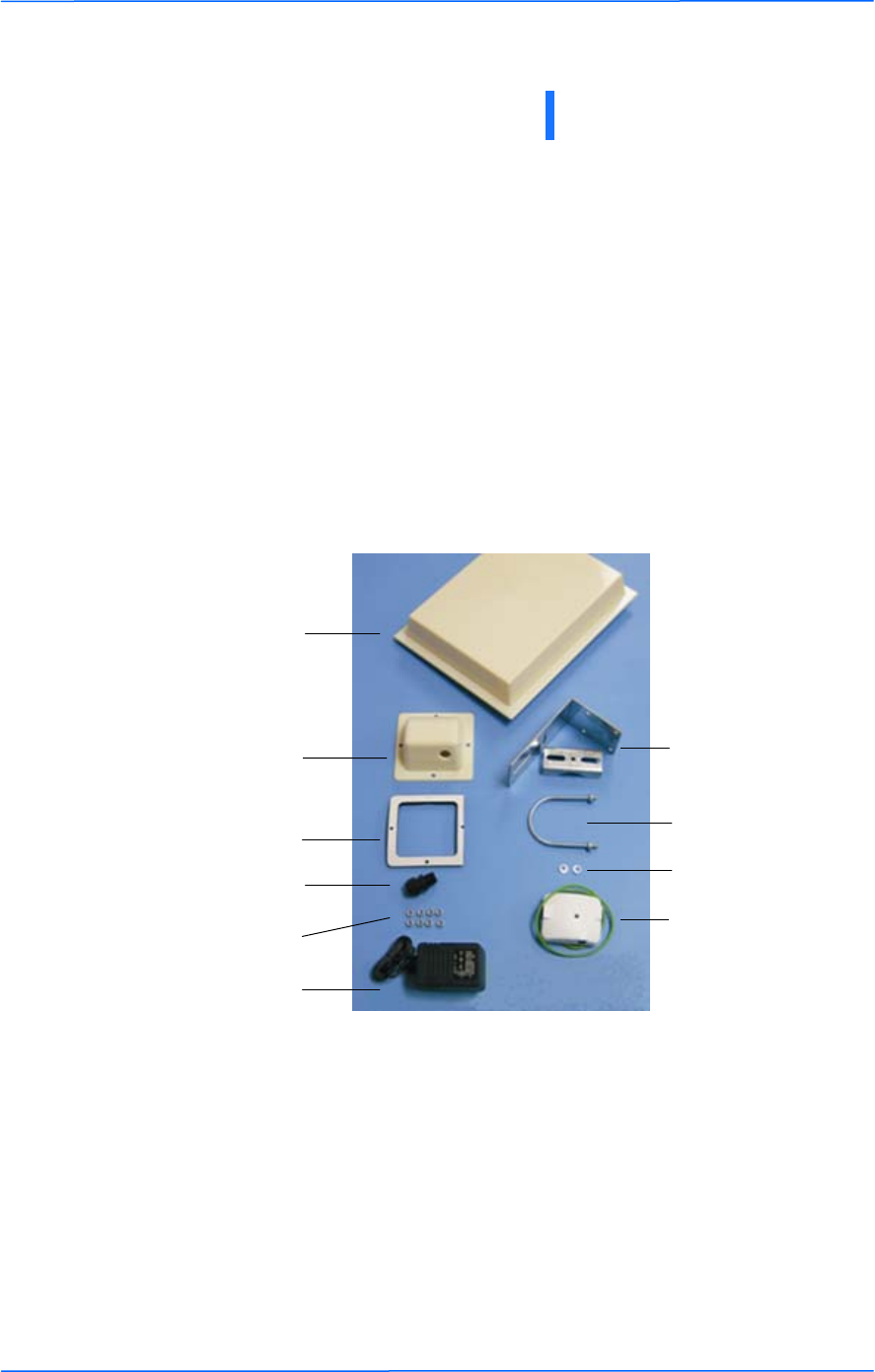
111
This document is intended for Public Distribution
19473 Fraser Way,
Pitt Meadows, B.C. Canada V3Y 2V4
Chapter 1: Overview
1-1
TR-Multi Series
Tranzeo Wireless Technologies
Introduction
The TR-Multi Series radios, the TR-Multi-N and TR-Multi-2, are advanced
customer premises equipments (CPE) that offer the dual band capabilities of
802.11b and 802.11a within one unit. These integrated, dual band/antenna radios
allow for quicker installs where they can be configured in either 2.4 GHz or 5 GHz
frequency, eliminating the need for two types of radios.
The TR-Multi-2 radios come with a built-in antenna. The TR-Multi-N radios do
not include an antenna, but have an interface for external antennas.
Product Kit
The TR-Multi Series product kit contains the items shown below. If any item is
missing or damaged, contact your local dealer for support.
Chapter 1: Overview
DC power
adapter x 1
Keps nuts x 8
TR-Multi-N/
TR-Multi-2 x 1
Ethernet boot
cover x 1
Gasket x 1
Strain relief x 1
Mounting bracket x 1
U-bolt w/ 2 nuts x 1
Lock washers x 2
POE adapter x 1

222
This document is intended for Public Distribution
19473 Fraser Way,
Pitt Meadows, B.C. Canada V3Y 2V4
Chapter 1: Overview
1-2
TR-Multi Series
Tranzeo Wireless Technologies
Product Description
The LEDs, ports and product information are located at the back of the TR-Multi
Series radio, as shown in the picture.
LED Panel Indicators
*Note: Color of the LED panel indicators may vary.
Label Color * Indicators
Power ● Red On: Powered on
Off: No power
LAN ● Green
On: Ethernet link
Flashing: Ethernet traffic
Off: No Ethernet link
Radio ● Amber
On: Radio link
Flashing: Radio activity
Off: No radio link
LED Panel indicators
MAC address
Ethernet ports
Serial number Studs for the boot
cover
Studs for the
mounting bracket

111
This document is intended for Public Distribution
19473 Fraser Way,
Pitt Meadows, B.C. Canada V3Y 2V4
Chapter 2: Hardware Installation
2-1
TR-Multi Series
Tranzeo Wireless Technologies
The TR-Multi Series radios are easy to install, as you’ll see in this chapter. Before
starting, you will need to get the tools listed below and decide about the site and
orientation of the device. Once ready, follow the instructions about how to install
the Ethernet cable, mount the device, ground the antenna, and make the
connections in order to get a proper installation.
Getting Ready
Tools Required
To install your TR-Multi Series radio you will need the following tools:
• 1/2” wrench x 1
• 3/8” wrench x 1
• 3/4” wrench x 1
• Cat 5 cable stripper x 1
• Cat 5 cable (to connect the radio to the POE adapter)
• RJ-45 patch cable
• RJ-45 crimper x 1
• RJ-45 connectors x 4
• #6 green grounding wire
Site Selection
Determine the location of the radio before installation. Proper placement of the
device is critical to ensure optimum radio range and performance. You should
perform a site survey to determine the optimal location.
Ensure the CPE is within line-of-sight of the access point. The line-of-sight is an
ellipse, called Fresnel zone. This zone should be clear of obstacles since
obstructions will impede performance of the device.
Fresnel zone
Chapter 2: Hardware Installation

222
This document is intended for Public Distribution
19473 Fraser Way,
Pitt Meadows, B.C. Canada V3Y 2V4
Chapter 2: Hardware Installation
2-2
TR-Multi Series
Tranzeo Wireless Technologies
Polarity
Determine if the antenna’s polarization will be horizontal or vertical before
installation. The TR-Multi Series radios can be used in either polarity. The
Ethernet boot cover should always be placed so that the cable runs toward the
ground for maximum environmental protection.
Power Supply
Only use a power adapter approved for use with the TR-Multi Series radio.
Otherwise, the product may be damaged and will not be covered by the Tranzeo
warranty.

333
This document is intended for Public Distribution
19473 Fraser Way,
Pitt Meadows, B.C. Canada V3Y 2V4
Chapter 2: Hardware Installation
2-3
TR-Multi Series
Tranzeo Wireless Technologies
Installing the Ethernet Cable
Step 2:
Using a 3/4” wrench, tighten the strain
relief until it touches the boot cover.
IMPORTANT! Use hand tools only. Do
not over tighten.
Step 3:
Put the cap nut back over the strain relief
and insert the Cat 5 cable through it. Wire
the cable following the EIA/TIA T568B
standard, and attach the RJ-45 connectors
to each end of the cable. (See Appendix G:
Wiring Standard).
Step 1:
Insert the strain relief, without the cap nut,
into the port opening of the boot cover.
Step 4:
If you purchased the device with a dual
port cover, repeat steps 1, 2, and 3 for the
second port.
IMPORTANT! If you are not going to use
the second port, insert the strain relief into
the boot cover and tighten the cap nut to
ensure a weather-tight seal, as shown in
the picture.

444
This document is intended for Public Distribution
19473 Fraser Way,
Pitt Meadows, B.C. Canada V3Y 2V4
Chapter 2: Hardware Installation
2-4
TR-Multi Series
Tranzeo Wireless Technologies
Step 7:
Fit the boot cover over the 4 studs and the
gasket. Secure with 4 keps nuts. Tighten
with a 3/8” wrench until the gasket is at
least 50% compressed.
Step 5:
Place the gasket—with the adhesive side
facing up—over the 4 studs around the port
of the radio. Flatten the gasket ensuring
there are no gaps. Remove the backing.
Step 8:
Make sure the cap nut of the strain relief is
tightened properly to ensure a weather-
proof seal.
IMPORTANT! Hand tighten only. Do not
over tighten as you may damage the
weather-tight seal of the strain relief.
Step 6:
Plug the Cat 5 cable inserted in the boot
cover into the port. Remember to place the
boot cover according to the desired
polarization, so that the strain relief faces
the ground.

555
This document is intended for Public Distribution
19473 Fraser Way,
Pitt Meadows, B.C. Canada V3Y 2V4
Chapter 2: Hardware Installation
2-5
TR-Multi Series
Tranzeo Wireless Technologies
Mounting the Radio
Step 9:
Attach the mounting bracket to the pole
using the U-bolt. Secure the U-bolt with
the lock washers and the nuts. Align if
necessary, and then tighten the nuts enough
to prevent any movement.
Step 10:
Fit the radio to the mounting bracket.
Secure the radio with keps nuts.
IMPORTANT! The strain relief must be
always facing the ground.
Grounding the Antenna
Step 11:
Using a #6 green grounding wire, connect
the grounding lug on the radio to a proper
ground. See Appendix A: Grounding and
Lighting Protection Information.
IMPORTANT: This device must be grounded. Connect the green grounding wire
to a known good earth ground, as outlined in the National Electrical Code. See
Appendix A: Grounding and Lightning Protection Information for details.
!
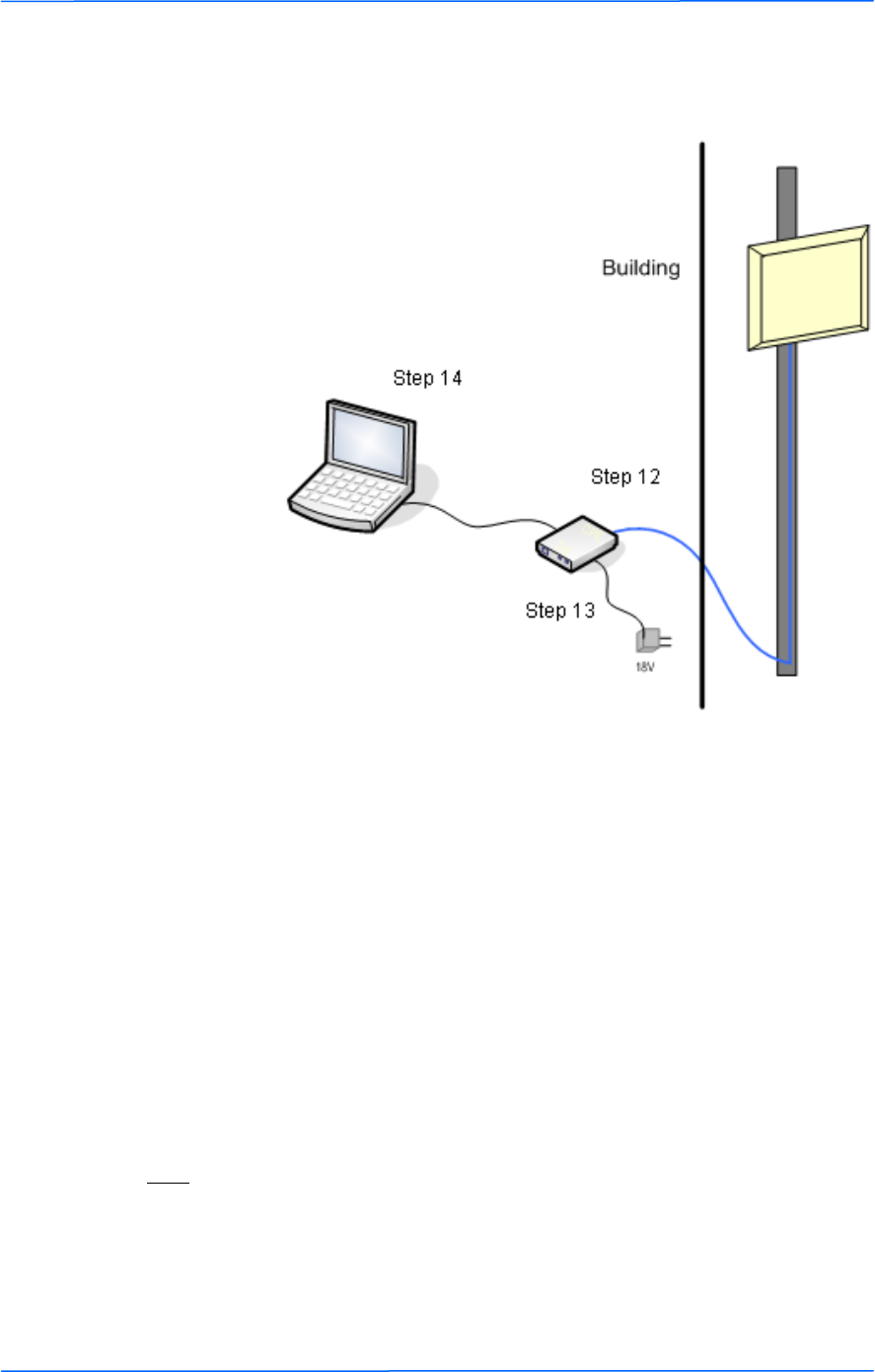
666
This document is intended for Public Distribution
19473 Fraser Way,
Pitt Meadows, B.C. Canada V3Y 2V4
Chapter 2: Hardware Installation
2-6
TR-Multi Series
Tranzeo Wireless Technologies
Connecting the Radio
Step 14:
To configure the TR-Multi Series radio,
connect the Ethernet cable to the POE
adapter and to a computer. Ensure that the
distance between the computer and the
radio does not exceed 300 ft (90 m).
Note: If connecting to a hub or switch, a
crossover cable may be required.
IMPORTANT! Use the power adapter
supplied with the radio. Otherwise, it may
be damaged.
Step 12:
Connect the Cat 5 cable from the radio into
the RJ-45 jack marked “CPE” on the POE
adapter. The POE adapter is not weather-
proof and should be installed indoors.
Step 13:
Connect the power adapter to the POE
adapter and plug the other end to an outlet.
The POE adapter will be powered on and
the power indicator on the top panel will
turn on. We recommend to connect the
power adapter to an outlet with surge
suppression capability with an uninterrupted
power supply (UPS) for reduced outages.

777
This document is intended for Public Distribution
19473 Fraser Way,
Pitt Meadows, B.C. Canada V3Y 2V4
Chapter 2: Hardware Installation
2-7
TR-Multi Series
Tranzeo Wireless Technologies
Best Practices
Follow these practices to ensure a correct installation and grounding.
• Always try to run long Cat 5 and LMR cables inside of the mounting pole.
This helps to insulate the cable from any air surges.
• Keep all runs as straight as possible. Never put a loop into the cables.
• Test all grounds to ensure that you are using a proper ground. If using an
electrical socket for ground, use a socket tester, such as Radio Shack 22-141.
• Keep a copy of the National Electrical Code Guide at hand and follow its
recommendations.
• If you are in doubt about the grounding at the location, drive your own rod
and bond it to the house ground. At least you will know that one rod is
correct in the system.

111
This document is intended for Public Distribution
19473 Fraser Way,
Pitt Meadows, B.C. Canada V3Y 2V4
Chapter 3: Configuration
3-1
TR-Multi Series
Tranzeo Wireless Technologies
The TR-Multi Series radios can be configured through an HTML configuration
interface, accessible using any Internet browser. The configuration interface
allows you to define and change settings, and also shows information about the
performance of the device.
In this chapter we’ll cover how to:
• Access the configuration interface
• Configure the TR-Multi Series radio
• Interpret the information displayed in the interface
Connecting to the Radio
Before accessing the configuration interface, you have to change the network
connection settings in your computer to be on the same subnet as the radio.
Changing the IP Address - Windows XP
1. In your computer, open Control Panel > Network Connections > Local Area
Connection.
2. In Local Area Connection Status > General, click Properties.
3. In Local Area Connection Properties > General, select Internet Protocol
(TCP/IP) and click Properties.
4. In Internet Protocol (TCP/IP) Properties > General, select Use the following
IP address.
5. Enter your IP address and Subnet Mask. The default IP address of the radio
is 192.168.1.100, which cannot be used here.
6. Click OK and Close.
Chapter 3: Configuration
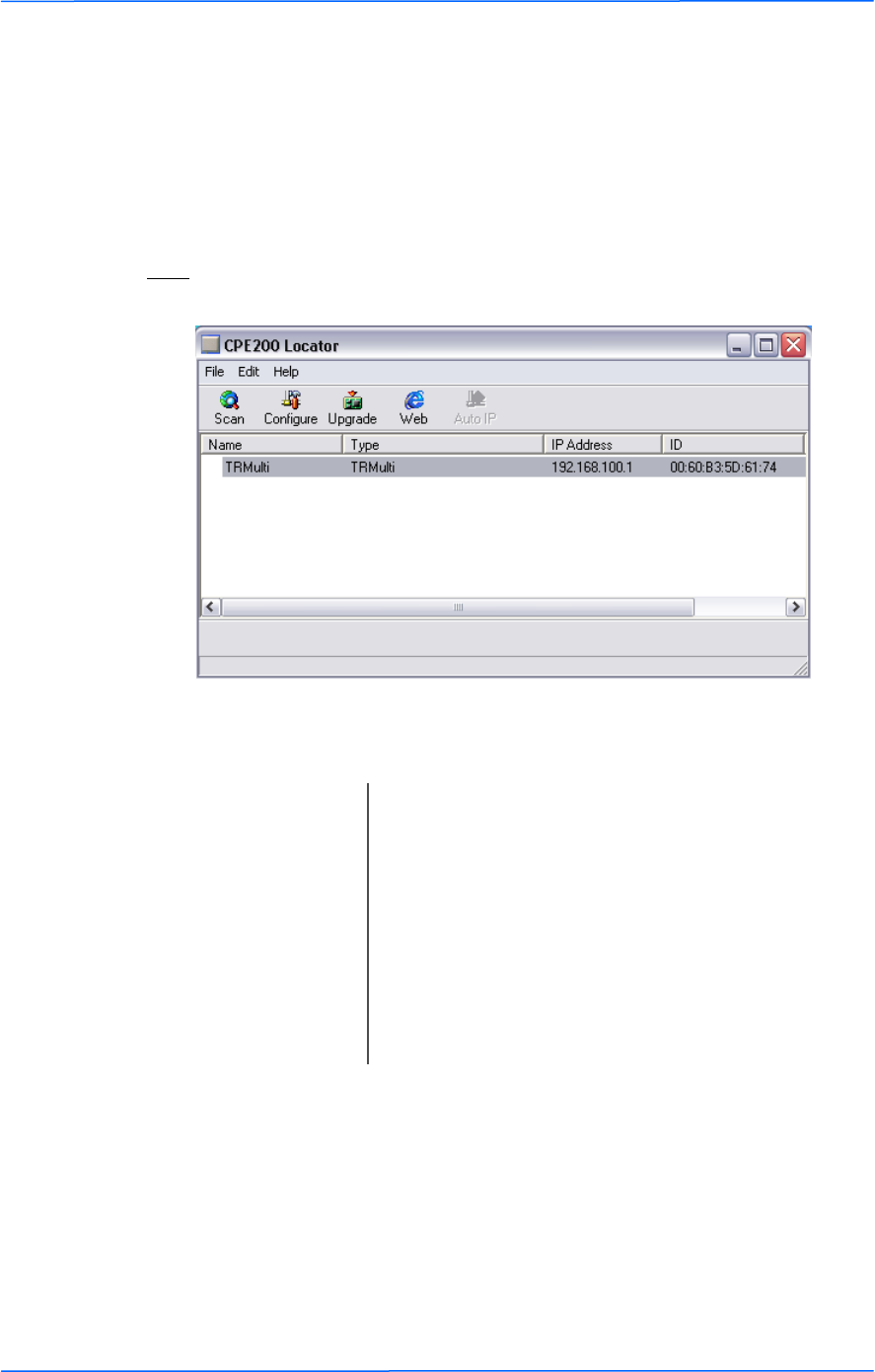
222
This document is intended for Public Distribution
19473 Fraser Way,
Pitt Meadows, B.C. Canada V3Y 2V4
Chapter 3: Configuration
3-2
TR-Multi Series
Tranzeo Wireless Technologies
Changing the IP Address Using the Tranzeo Locator
The Tranzeo Locator is a utility that allows users to quickly change the IP address
of the Tranzeo radios. It sends out a broadcast on the network and displays a list of
other Tranzeo radios connected, from which you can configure the IP address for
your device.
Note: The Locator cannot locate radios through routers.
The Tranzeo Locator displays the following options:
Find the latest version of the Tranzeo Locator at www.tranzeo.com, under Tranzeo
Support > Support Files > Radio Utilities.
Scan: Locates Tranzeo radios connected to the network. A
yellow icon appears before the name when the radio is
not in the same subnet.
Configure: Used to set a static IP address or set the radio into
DHCP mode.
Upgrade: Under development.
Auto IP: To automatically set the radio to an IP address one
number higher than the IP address of the computer.
Web: Opens a browser to access the configuration interface.
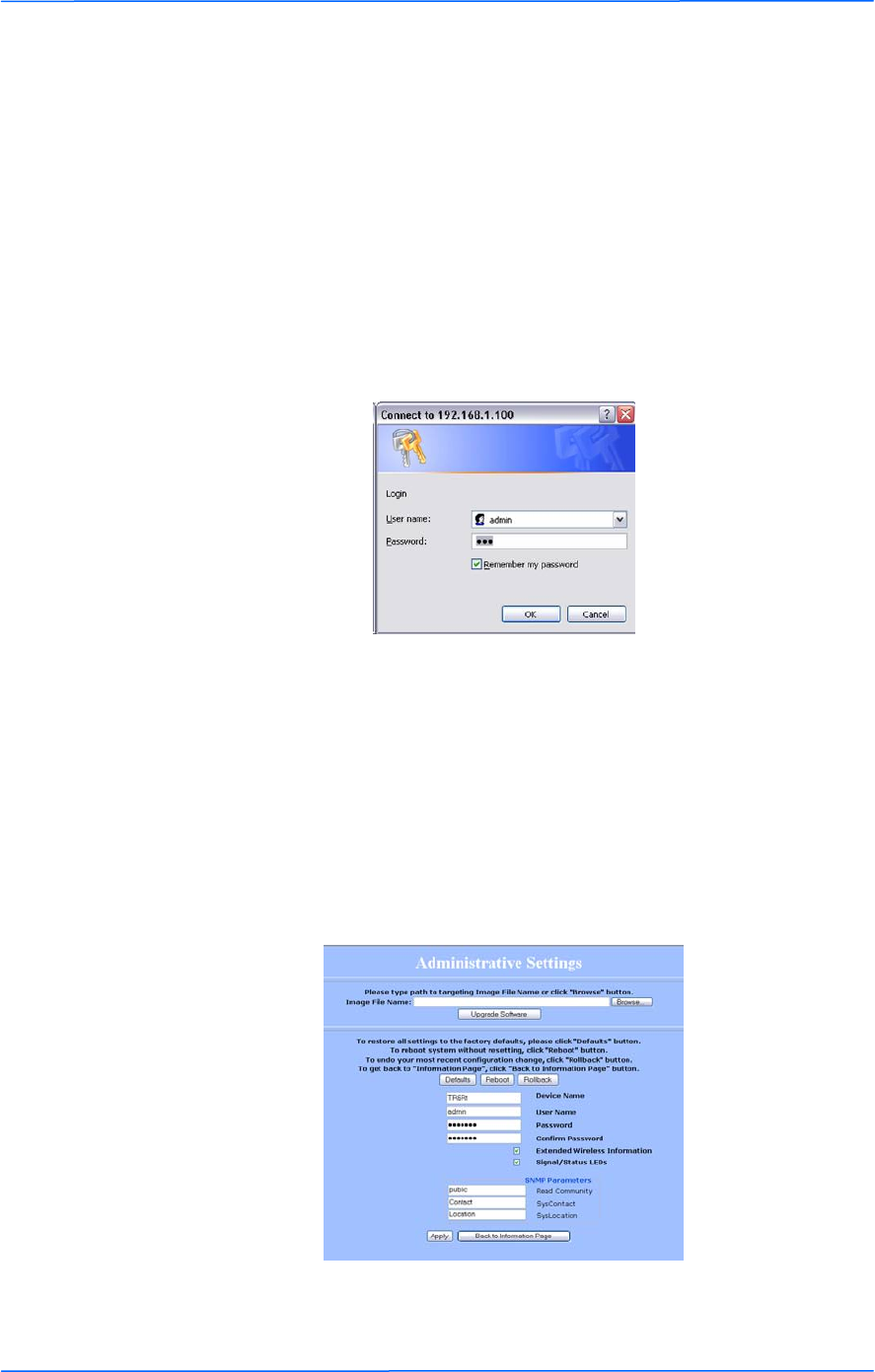
333
This document is intended for Public Distribution
19473 Fraser Way,
Pitt Meadows, B.C. Canada V3Y 2V4
Chapter 3: Configuration
3-3
TR-Multi Series
Tranzeo Wireless Technologies
Login into the Configuration Interface
After defining the network settings, follow these steps to login into the Tranzeo
Configuration Interface.
1. Open your Internet browser (Internet Explorer, Netscape, or Firefox).
2. In the address bar, type http://192.168.1.100.
3. In the login dialog, enter your Username and Password (if you’re a first-
time user, follow the instructions below).
4. Click OK. You will then access the configuration interface.
If you’re a first-time user:
1. Enter the default username admin and the default password default.
2. In the Password Set/Reset window, change the Administration and
Recovery* passwords. They cannot be left as default and must be different
from each other. You can change the usernames too.
3. Click Apply to save the changes.
4. You will be prompted to enter your new username and password in the login
dialog. You will then access the configuration interface.
* The recovery username and password are used to access the Password Set/Reset
window if the administration password is lost.

444
This document is intended for Public Distribution
19473 Fraser Way,
Pitt Meadows, B.C. Canada V3Y 2V4
Chapter 3: Configuration
3-4
TR-Multi Series
Tranzeo Wireless Technologies
Information Page
This is the first window of the configuration interface. It shows the main menu and
information about the device settings, like wireless, network, and security settings.
The menu is divided in four sections:
• Setup Menu
• Security
• Status
• Network
Each section contains navigation links to the configuration windows.
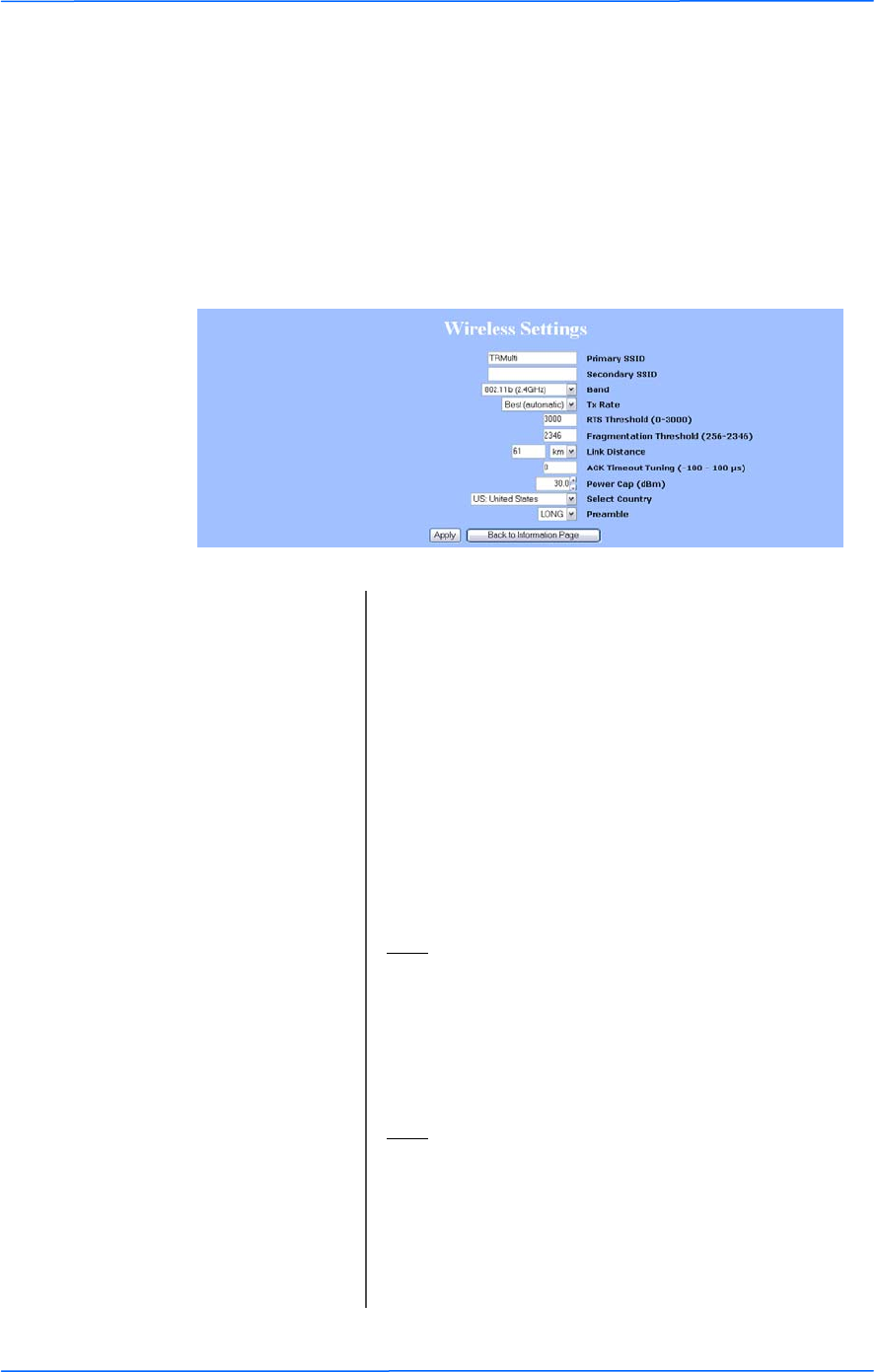
555
This document is intended for Public Distribution
19473 Fraser Way,
Pitt Meadows, B.C. Canada V3Y 2V4
Chapter 3: Configuration
3-5
TR-Multi Series
Tranzeo Wireless Technologies
CPE Setup Menu
In this section you would be able to configure wireless and administrative settings
for the TR-Multi Series radio.
Wireless Settings
This window displays the wireless configuration of the device.
Primary SSID: The Service Set Identifier (SSID) is the name that
identifies a specific wireless LAN. Devices must have
the same SSID to communicate with each other. The
primary SSID corresponds to the primary access point.
Secondary SSID: If using two access points in the network, enter the
SSID of the secondary access point in this field.
Clients will connect to the secondary access point
when the primary is unavailable.
Band: The radio frequency range in which the radio operates
(2.4 or 5.8 GHz).
TX Rate: The transmission speed at which the radio
communicates with the access point.
Note: Setting this rate below the maximum possible
does not limit bandwidth and often has a negative
impact on the operation of your network.
RTS Threshold: This is the maximum size for a packet to be sent
automatically. When it exceeds the RTS threshold, the
CPE sends first a ‘request to send’ (RTS) to the access
point before sending the packet.
Note: The more clients you have, the lower the value
should be set.
Fragmentation
Threshold: This is the size at which packets are fragmented in
order to be transmitted. Setting this value too low
decreases the amount sent on each transmission. In
noisy areas, this can improve performance. However,
in quiet areas, this will decrease throughput.

666
This document is intended for Public Distribution
19473 Fraser Way,
Pitt Meadows, B.C. Canada V3Y 2V4
Chapter 3: Configuration
3-6
TR-Multi Series
Tranzeo Wireless Technologies
Power Cap: Is the maximum output power of the radio.
Country: Select the country where the device is located. Setting
an incorrect country may be considered a violation of
the applicable law, as rules differ in each country.
Antenna Gain: Select the gain of the antenna used. This information
must be set by the installer at the time of installation.
Preamble: Select type: Long uses long preamble only, Auto
(recommended) tries short preamble first, then long.
ACK Timeout Tuning: The time that the device waits for an acknowledgment
from the access point accepting the transmission
before re-attempting to send the data. This is an offset
from the ACK timing set by the link distance.
Link Distance: This is the distance between the CPE and access
point. This setting is necessary to define the correct
ACK timing. Setting this value too low or too high
will result in low throughput and high retries.
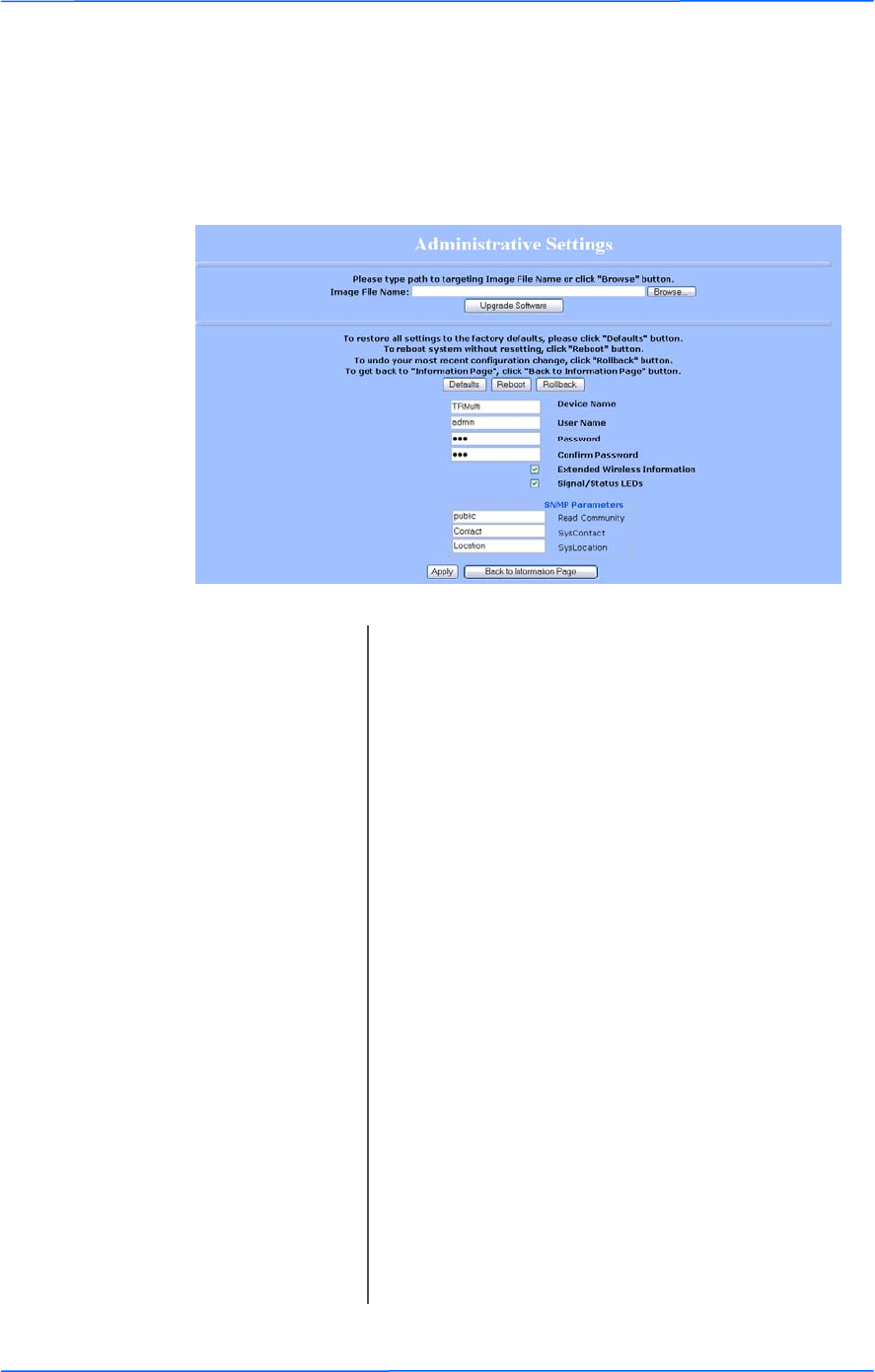
777
This document is intended for Public Distribution
19473 Fraser Way,
Pitt Meadows, B.C. Canada V3Y 2V4
Chapter 3: Configuration
3-7
TR-Multi Series
Tranzeo Wireless Technologies
Administrative Settings
Use this section to upgrade the software, change your password, and define SNMP
parameters.
Upgrade Software: Enter the location of the software update file or
Browse to locate it in your computer. Click Upgrade
Software. If the radio does not refresh the Information
Page after 1 minute, press Refresh, Reload or F5.
Verify the new firmware is installed correctly.
Defaults: Returns all settings to factory defaults, including
passwords.
Reboot: Restarts the system without changing settings.
Rollback: To undo the most recent change.
Device Name: It is the network name of the device. This name
appears in the Locator and on the Tranzeo stations list.
User Name: This is the login username.
Password: Enter a new password if you want to change it.
Confirm Password: Re-type the new password.
Extended Wireless
Information: Enables extended information (name and IP address),
which is only displayed with Tranzeo access points.
Signal/Status LEDs: Un-check to turn off the LED panel indicators.
SNMP Parameters: Here you set the Read Community string and
Contact/Location information. It’s highly
recommended that you change the Read Community
string immediately to prevent unauthorized scanning
of your network.
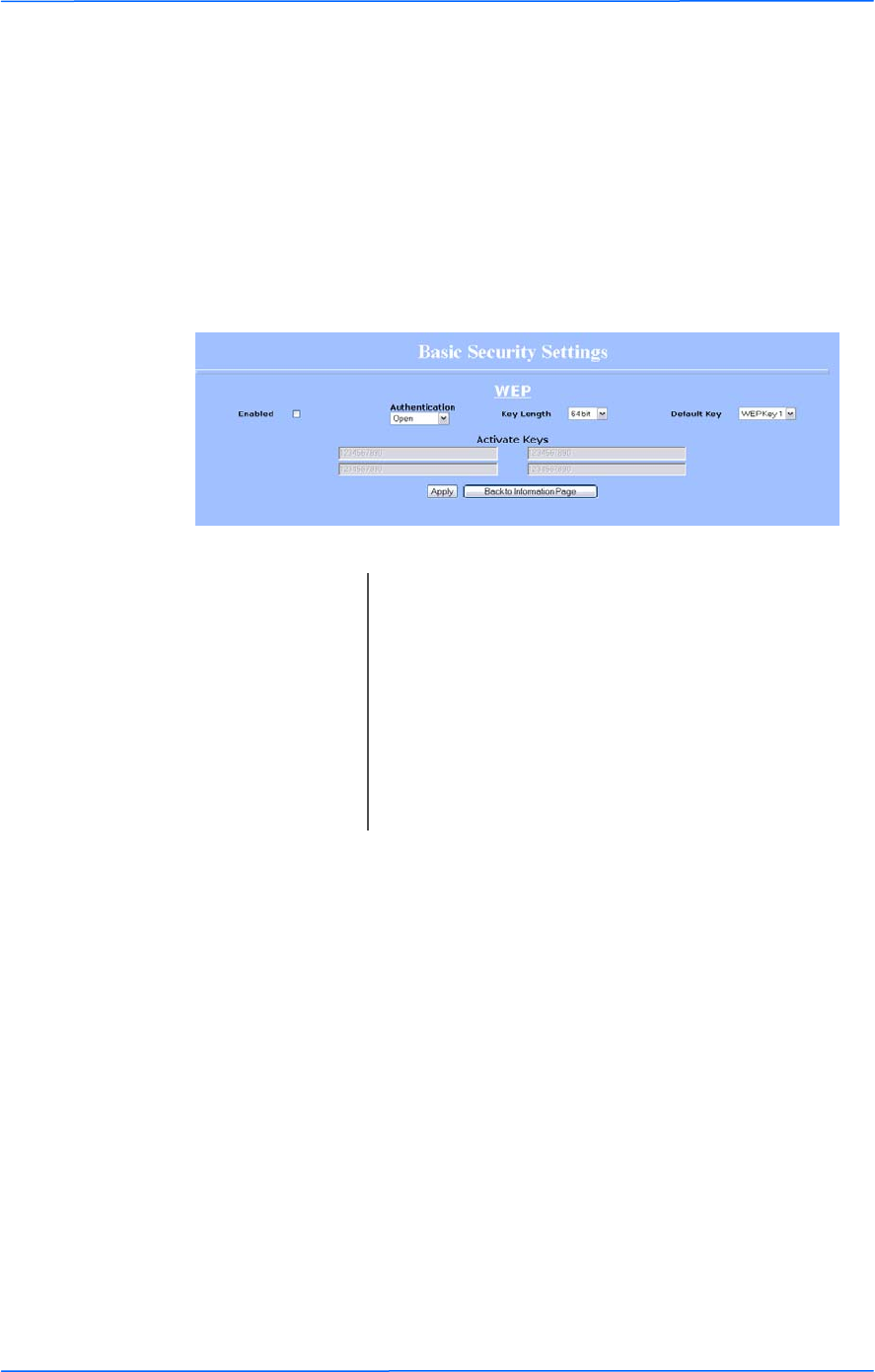
888
This document is intended for Public Distribution
19473 Fraser Way,
Pitt Meadows, B.C. Canada V3Y 2V4
Chapter 3: Configuration
3-8
TR-Multi Series
Tranzeo Wireless Technologies
Security
In this section you can configure both basic and advanced security settings for
your device.
Basic Security Settings
In this window you can define WEP parameters. WEP provides security by
encrypting data so that it’s protected when transmitted from one point to another.
Enabled: Check to turn on WEP security protocol.
Authentication: Select your system to be open or shared. Open is
always recommended.
Key Length: This is the level of encryption. Note that 64 bit is
referred to as 40 bit on some systems.
Default Key: Select the default WEP key from the list.
Activate Keys: Enter the four WEP keys you want to activate. Keys
must be entered in HEX only.
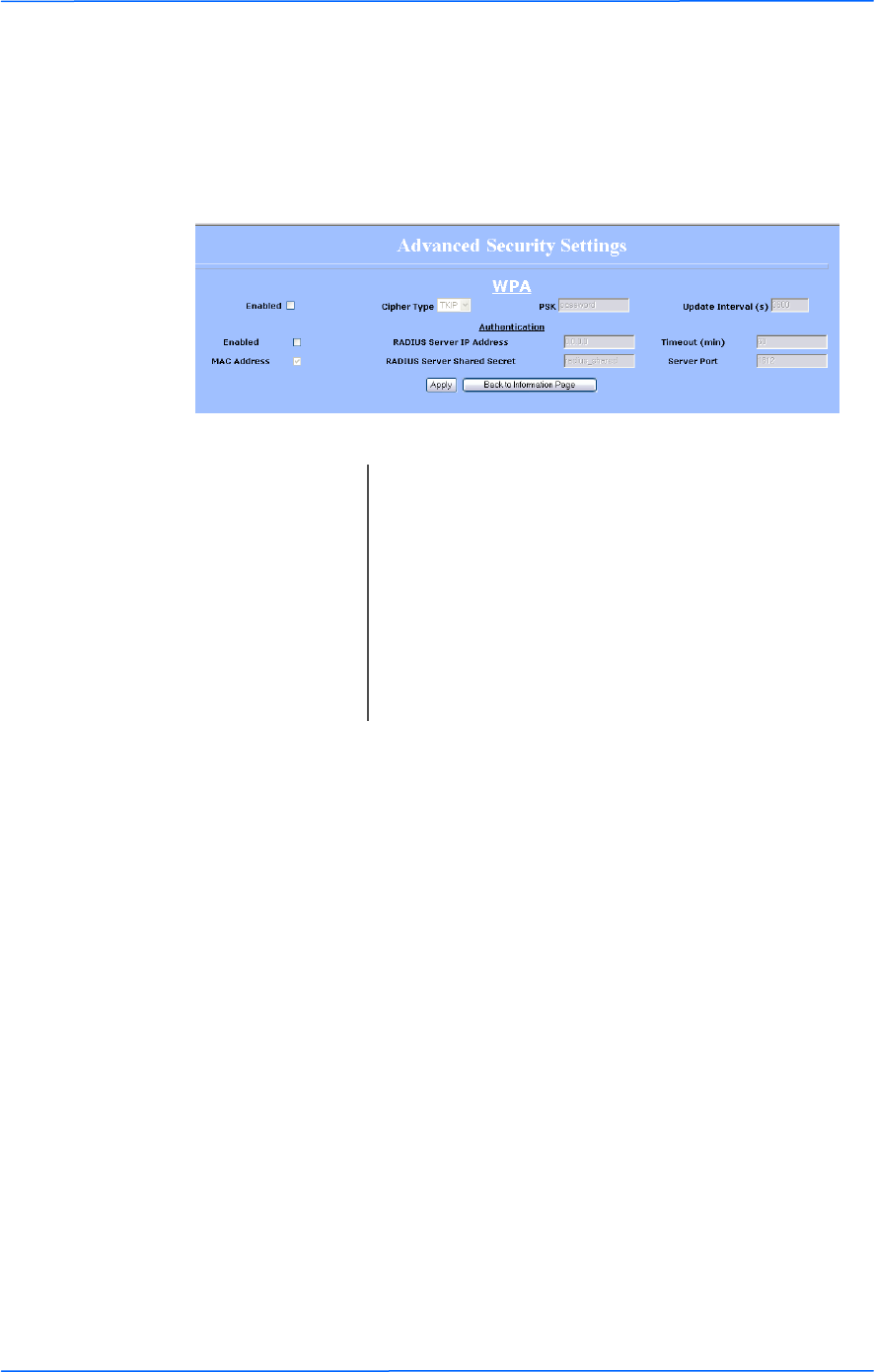
999
This document is intended for Public Distribution
19473 Fraser Way,
Pitt Meadows, B.C. Canada V3Y 2V4
Chapter 3: Configuration
3-9
TR-Multi Series
Tranzeo Wireless Technologies
Advanced Security Settings
In this window you can enter WPA parameters. WPA provides a higher level of
security, enhancing the security features of WEP.
Enabled: Check to turn on WPA.
Cipher Type: Select the level of encryption.
PSK: Enter your PSK password.
Authentication: Ensures that only authorized network users can access
the network. Enter the information about the RADIUS
server from your Internet Service Provider.
Update Interval: This is the interval at which the PSK password will be
updated.
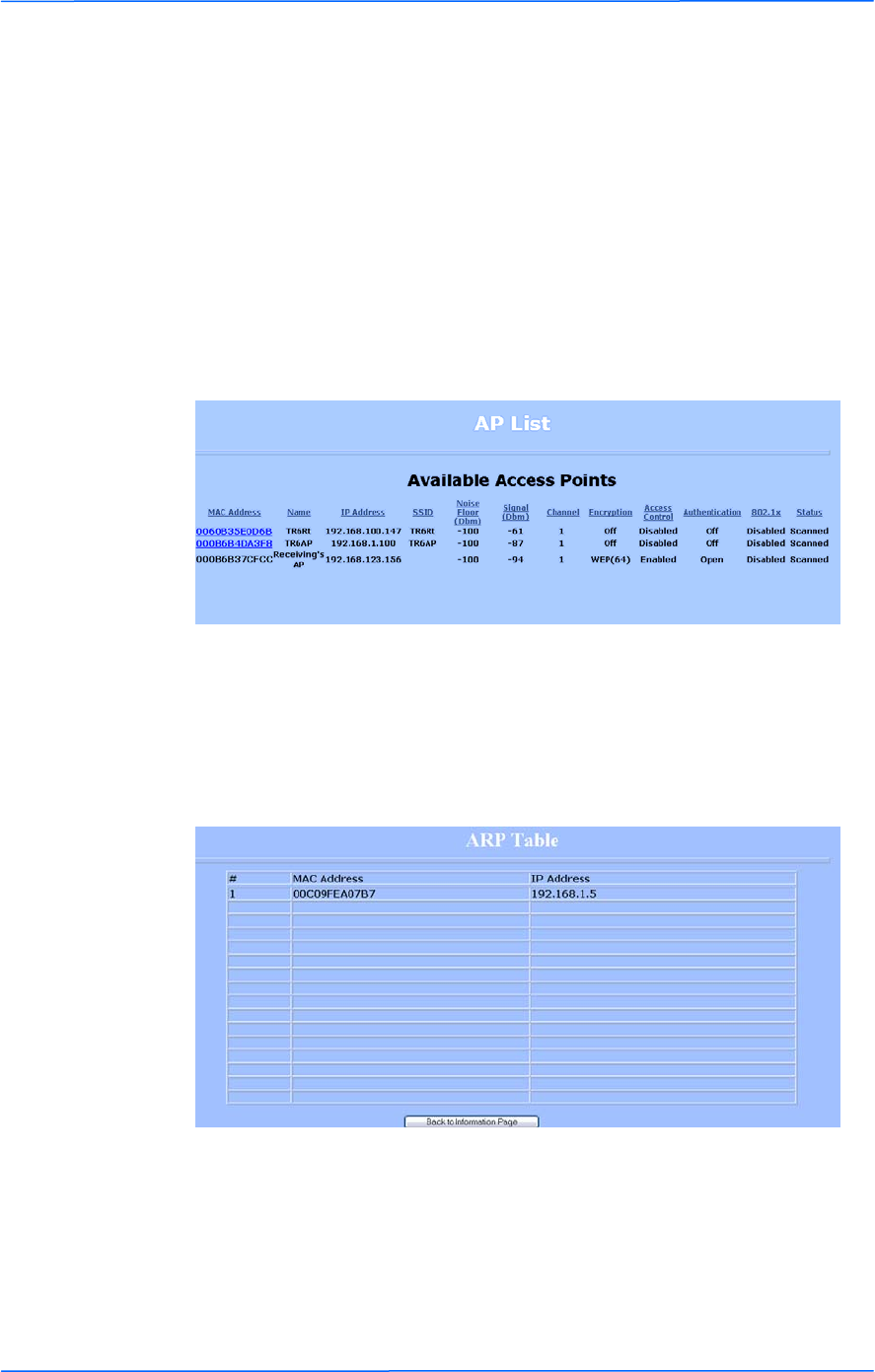
101010
This document is intended for Public Distribution
19473 Fraser Way,
Pitt Meadows, B.C. Canada V3Y 2V4
Chapter 3: Configuration
3-10
TR-Multi Series
Tranzeo Wireless Technologies
Status
This section displays information about the status and performance of your radio.
Most options and information cannot be modified in this section.
AP List
This window displays information about the access points associated with the CPE
and the connection statistics.
You can set an access point’s SSID as your primary SSID by clicking on the MAC
address when it’s displayed as a link. This will automatically reboot the radio.
ARP Table
This table lists the devices that have communicated with your device via TCP.
There should be a limited number of entries in this table, especially if the
interstation blocking is turned on at the access point.

111111
This document is intended for Public Distribution
19473 Fraser Way,
Pitt Meadows, B.C. Canada V3Y 2V4
Chapter 3: Configuration
3-11
TR-Multi Series
Tranzeo Wireless Technologies
Statistics
This section is divided in 3 windows: LMAC (Lower Mac), UMAC (Upper Mac),
and Ethernet, which can be accessed from the Statistic Summary Page.
LMAC Statistics
The LMAC functions occur in the radio chipset. While the UMAC divides the
statistics into clean and failed packets, LMAC defines why packets failed.
This window contains three tabs: TX, RX and INT. TX and RX values are useful
to ISPs and other users. The INT (internal) statistics are intended for use by
Tranzeo Wireless Technical Support.
You can click onto each speed level and see how the traffic breaks down. In the
TX statistics, there should little to no Tries at Series 2, 3 or 4. The radio will try to
send a packet 4 times at Series 1 and then will try the next series 4 times. In the
RX statistics, you should look for bad CRCs and bad decrypts for signs of RF
interference or Fresnel interference links. Bad PHYs generally are caused when
the radio is unable to decode the packets due to noise.
Note: Communication between access points and CPEs always occurs at the
lowest rate. In a normal link, you should see a fair number of transactions at the
lowest rate.
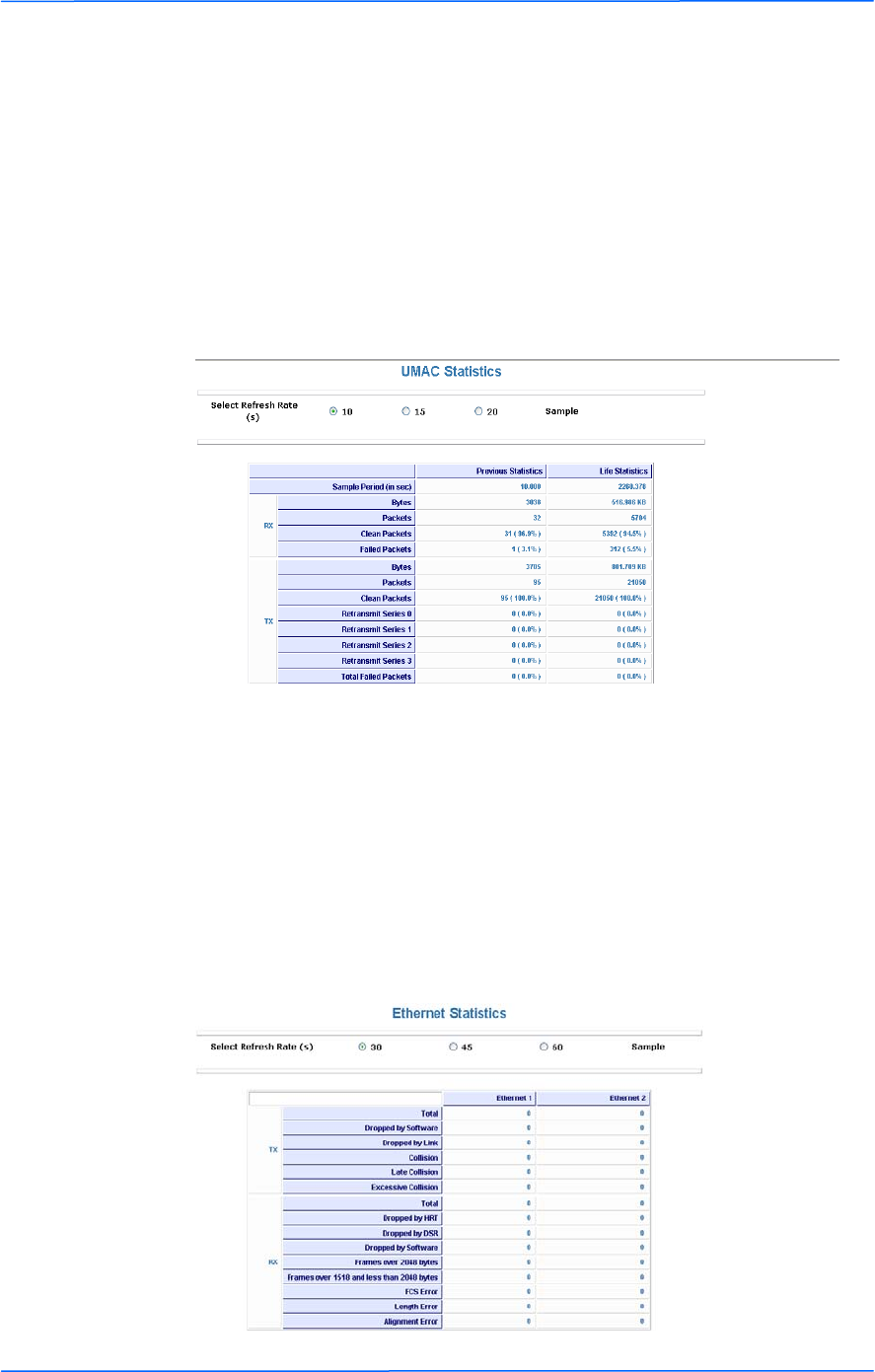
121212
This document is intended for Public Distribution
19473 Fraser Way,
Pitt Meadows, B.C. Canada V3Y 2V4
Chapter 3: Configuration
3-12
TR-Multi Series
Tranzeo Wireless Technologies
UMAC Statistics
The UMAC functions occur in the unit’s processor. The UMAC statistics are
likely the most useful for radio troubleshooting. This window breaks down the
statistics into clean and failed packets.
The failed packets should be less than 10% in a normal operating environment. In
the TX statistics, there should be little to no Retransmits at Series 2, 3 or 4. Life
Statistics are reset on each reboot.
Ethernet Statistics
In this window, excessive collisions are usually a sign that the radio and the device
it is linked to are not on the same duplex settings. One is at full while the other is
at half. Try locking both to the same values.
Collisions do normally occur on an Ethernet network and are generally handled by
the Carrier Sense Multiple Access with Collision Detect (CSMA/CD) mechanism.
Alignment, length and excessive FCS errors could the result of a bad radio link, or
a bad Ethernet cable.
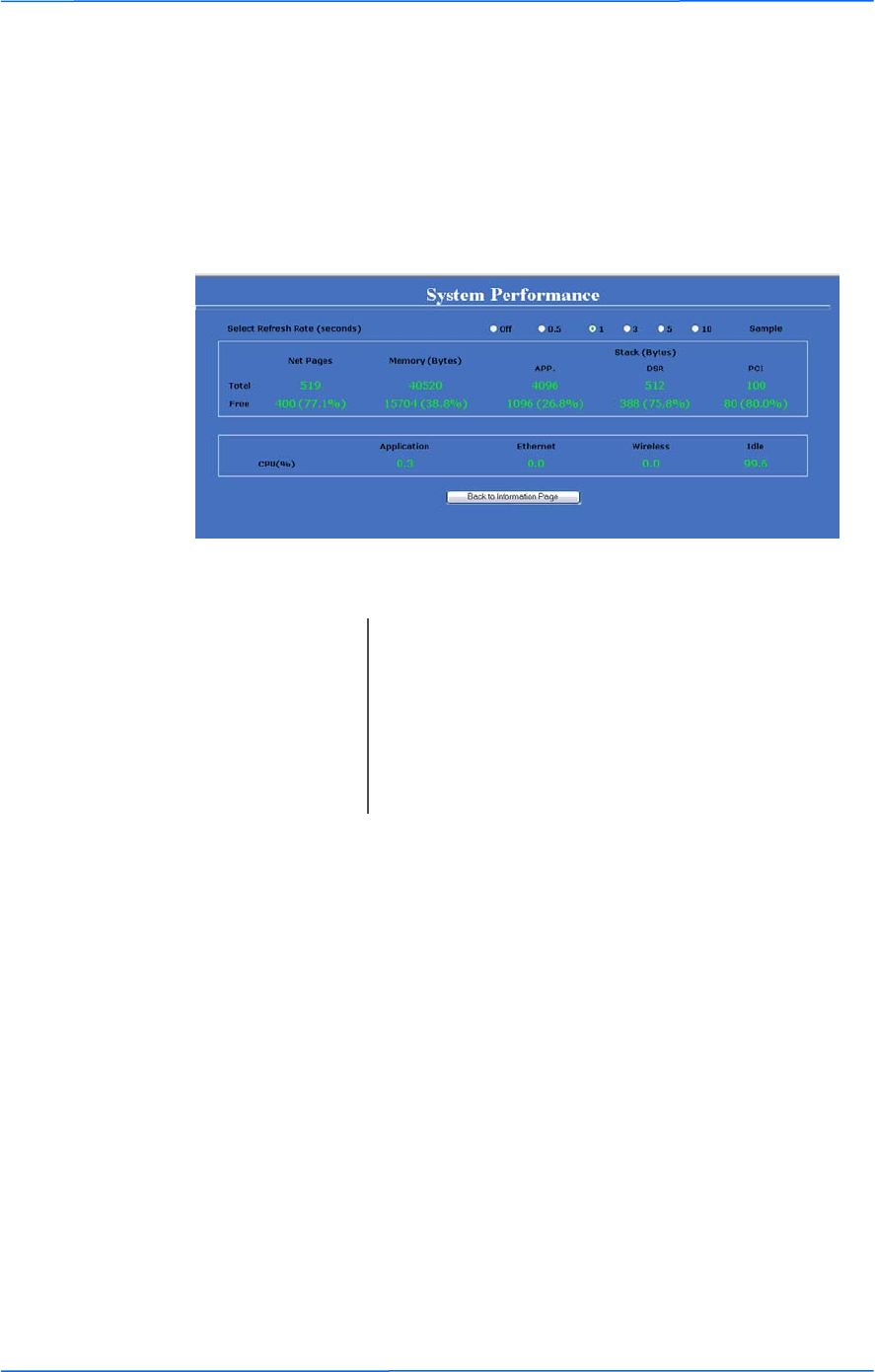
131313
This document is intended for Public Distribution
19473 Fraser Way,
Pitt Meadows, B.C. Canada V3Y 2V4
Chapter 3: Configuration
3-13
TR-Multi Series
Tranzeo Wireless Technologies
System Performance
This window shows information about the memory usage and the CPU. Many
browsers do not allow infinite refreshes of a page through scripts, so this window
may stop updating. If it does, simply change the refresh rate to another value to
restart the process.
Select Refresh Rate: Set the time for automatic refreshes.
Net Pages: This is the memory used for data transmission
Memory: This is the total memory of the system.
Stack: This section displays the memory used and available
for each stack: App. (applications), DSR, and PCI.
This information is relevant for programmers.
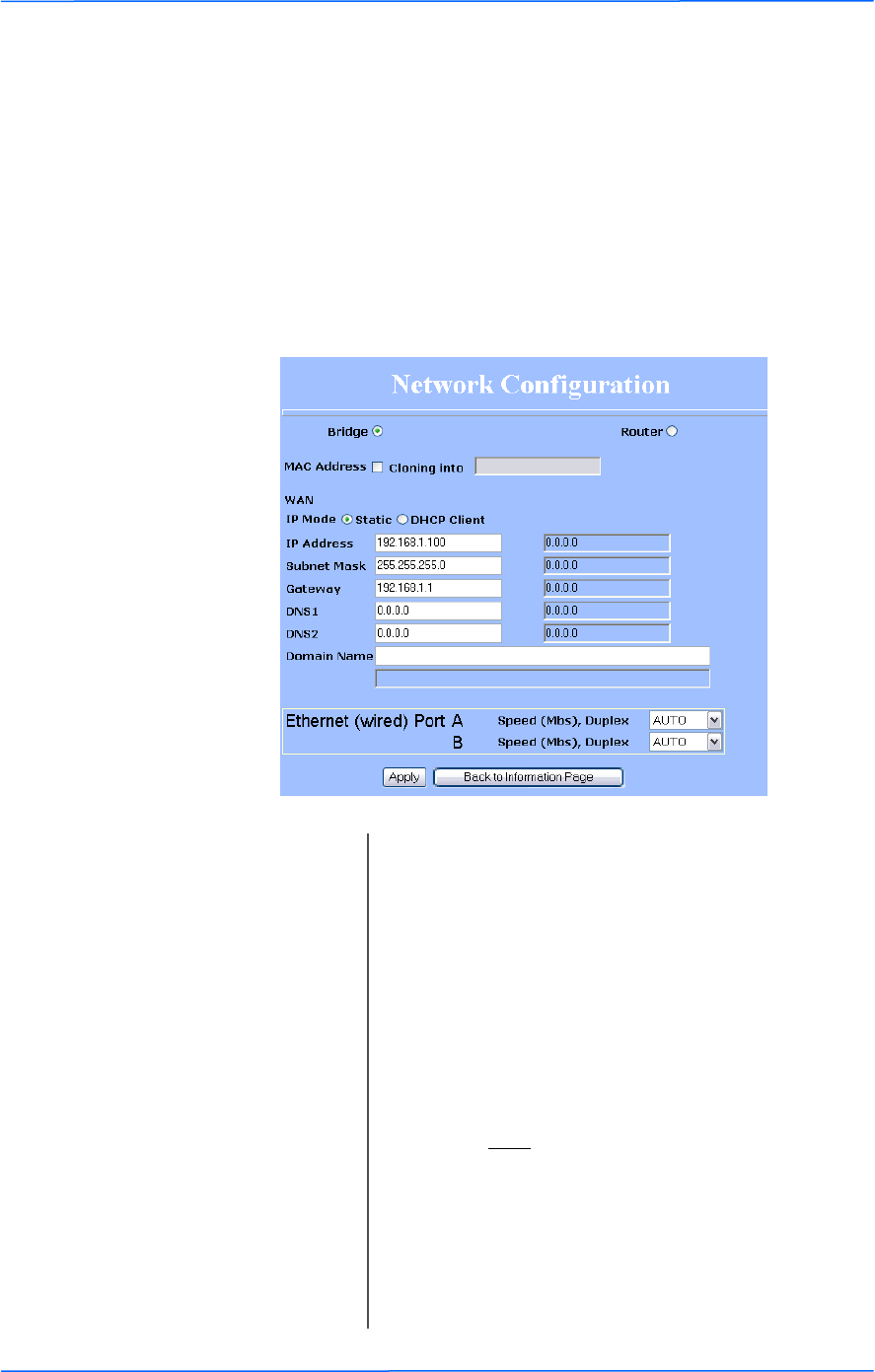
141414
This document is intended for Public Distribution
19473 Fraser Way,
Pitt Meadows, B.C. Canada V3Y 2V4
Chapter 3: Configuration
3-14
TR-Multi Series
Tranzeo Wireless Technologies
Network Configuration
In this window you can control the network configuration of the device. First, you
must define if your radio will operate as a bridge or router. The content of the
window varies depending on your selection.
When changing modes, the radio may need to reboot before certain features
become available.
Bridge Mode
Cloning MAC Address: This feature allows the radio to copy the MAC address
of the device you have connected to the network. This
is useful when you change your device and don’t want
to register a new MAC address, or when dealing with
some PPPoE and Radius implementations. When the
device is cloning a MAC address, it can only be
managed from the LAN side. To clone a MAC
address, check the MAC Address box and enter the
MAC address in the field Cloning into. Uncheck to
restore the original MAC address.
IP Mode: You can select to use Static IP or DHCP Client
(dynamic). Note: If a DHCP server is not available, the
device will try to get an IP. After that, it will use
fallback IP address.
WAN: Enter the information related to the WAN interface: IP
Address, Subnet Mask, Gateway, DNS1, DNS2, and
Domain Name.
Ethernet Port Speed: Set as Auto by default.
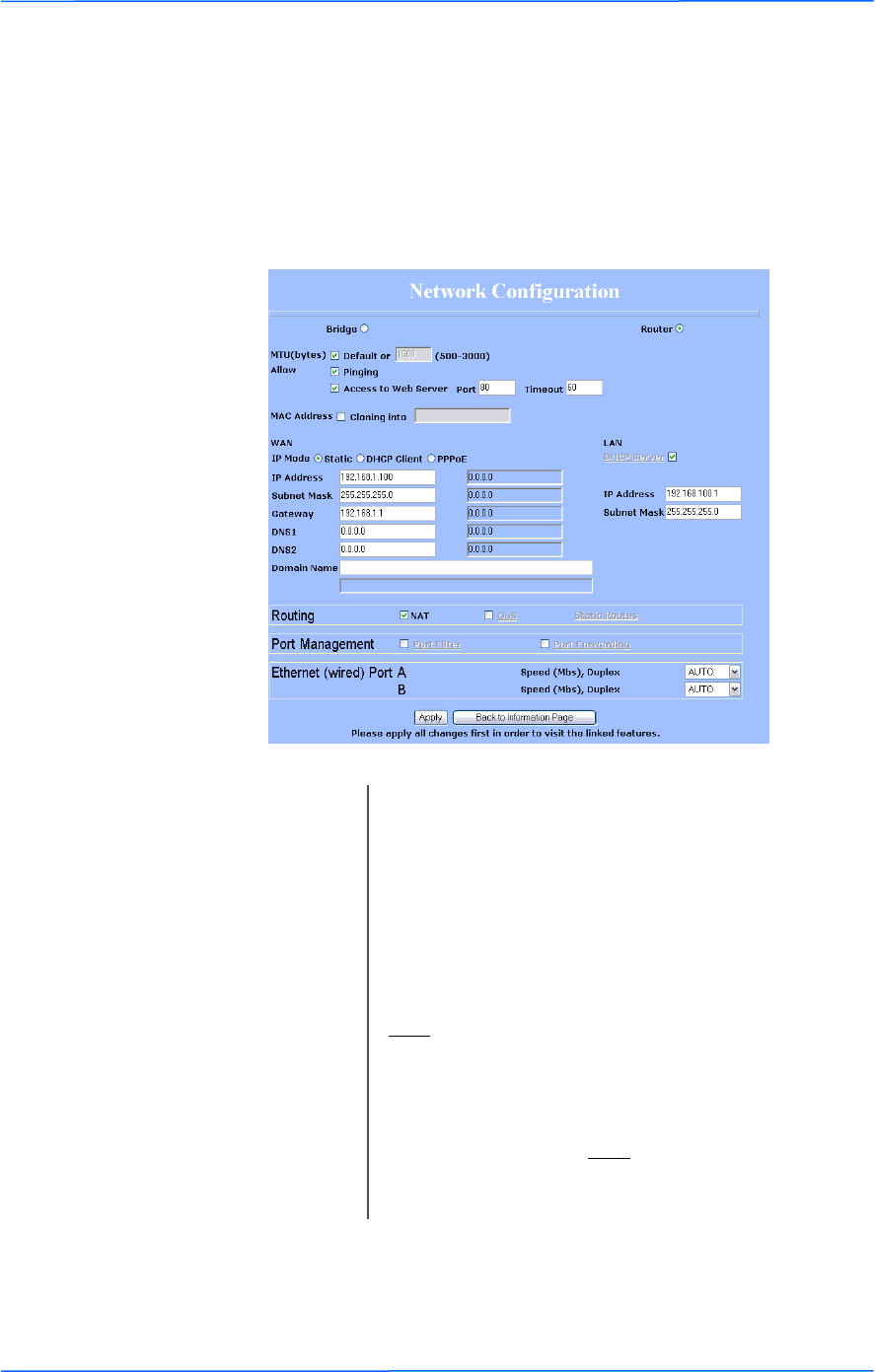
151515
This document is intended for Public Distribution
19473 Fraser Way,
Pitt Meadows, B.C. Canada V3Y 2V4
Chapter 3: Configuration
3-15
TR-Multi Series
Tranzeo Wireless Technologies
Router Mode
From this window you can access specific windows to configure the DHCP
Server, QoS, Static Routes, Port Filtering, and Port Forwarding. If the feature is
available, it will appear like a link. To open an item, just click on it. These features
are described in the next pages.
MTU: The Maximum Transmission Unit (MTU) refers to the
size of the largest packet that the router can pass. The
default value is 1500 bytes. If PPPoE is used, you
should change the MTU to match the PPPoE server,
typically 1492 bytes.
Allow Pinging: Enables ping responses on WAN interface.
Allow Access to Web
Server: Allows access from WAN interface or change the port
the WAN server responds to web server requests.
Note: Access to web server from LAN interface is
always enabled and set at port 80.
Cloning MAC Address: See description in Bridge Mode.
IP Mode: You can select to use Static IP, DHCP Client
(dynamic), or PPPoE. Note: If a PPPoE server is not
available, the device will try to get an IP. After that, it
will use fallback IP address.

161616
This document is intended for Public Distribution
19473 Fraser Way,
Pitt Meadows, B.C. Canada V3Y 2V4
Chapter 3: Configuration
3-16
TR-Multi Series
Tranzeo Wireless Technologies
Note:
Many Ethernet devices do not auto-negotiate properly. If you see large numbers of
dropped pings, you may have collisions. Try locking the device at 10/half as a
troubleshooting step. If the packet losses stop, step up to 100/full. If the device the
radio is connecting cannot support 100/full, you should replace the device or place
a switch in line.
WAN: Enter the information related to the WAN interface: IP
Address, Subnet Mask, Gateway, DNS1, DNS2, and
Domain Name.
Routing: Enables NAT, QoS, and Static Routes. NAT should
always be enabled when using private addressing.
Click on QoS or Static Routes to configure.
Port Management: Check the box and click Apply to enable port filtering
and port forwarding. Click on any item to open the
configuration window.
LAN: Enter the information related to the LAN interface: IP
address and subnet mask.
DHCP Server: Check the box and click Apply to enable this feature.
Click on the item (which now appears as a link) to
open the DHCP Server configuration window.
Ethernet Port Speed: Set as Auto by default.
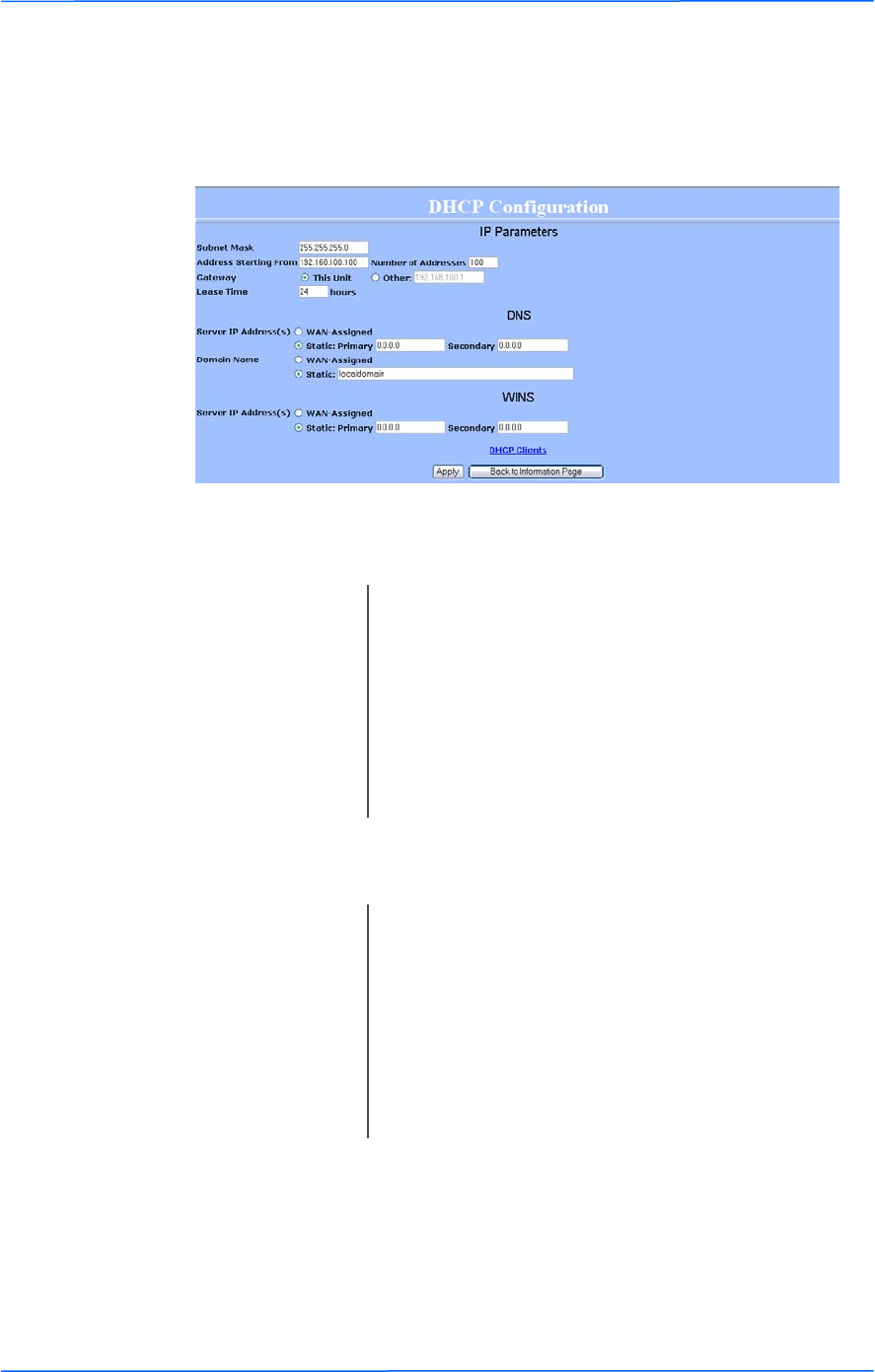
171717
This document is intended for Public Distribution
19473 Fraser Way,
Pitt Meadows, B.C. Canada V3Y 2V4
Chapter 3: Configuration
3-17
TR-Multi Series
Tranzeo Wireless Technologies
DHCP Configuration
This window shows the configuration of the DHCP server.
IP Parameters
DNS
Subnet Mask: Enter your subnet mask in this field.
Gateway: Select This Unit to use the gateway set on the WAN
interface. Select Other to use a different gateway.
Lease Time: Indicates the expiration time for the IP address
assigned by the DHCP server.
Address Starting from: Indicates the first address in the DHCP pool.
Number of Addresses: Indicates the number of addresses in the DHCP pool.
Server IP Address: Select WAN Assigned to use the DNS server IP
addresses assigned on the WAN side. To use different
DNS servers, select Static, in which case you must
enter the Primary and Secondary IP addresses.
Domain Name: Apply the same configuration as for Server IP
Address.
WINS: Apply the same configuration as for Server IP
Address.
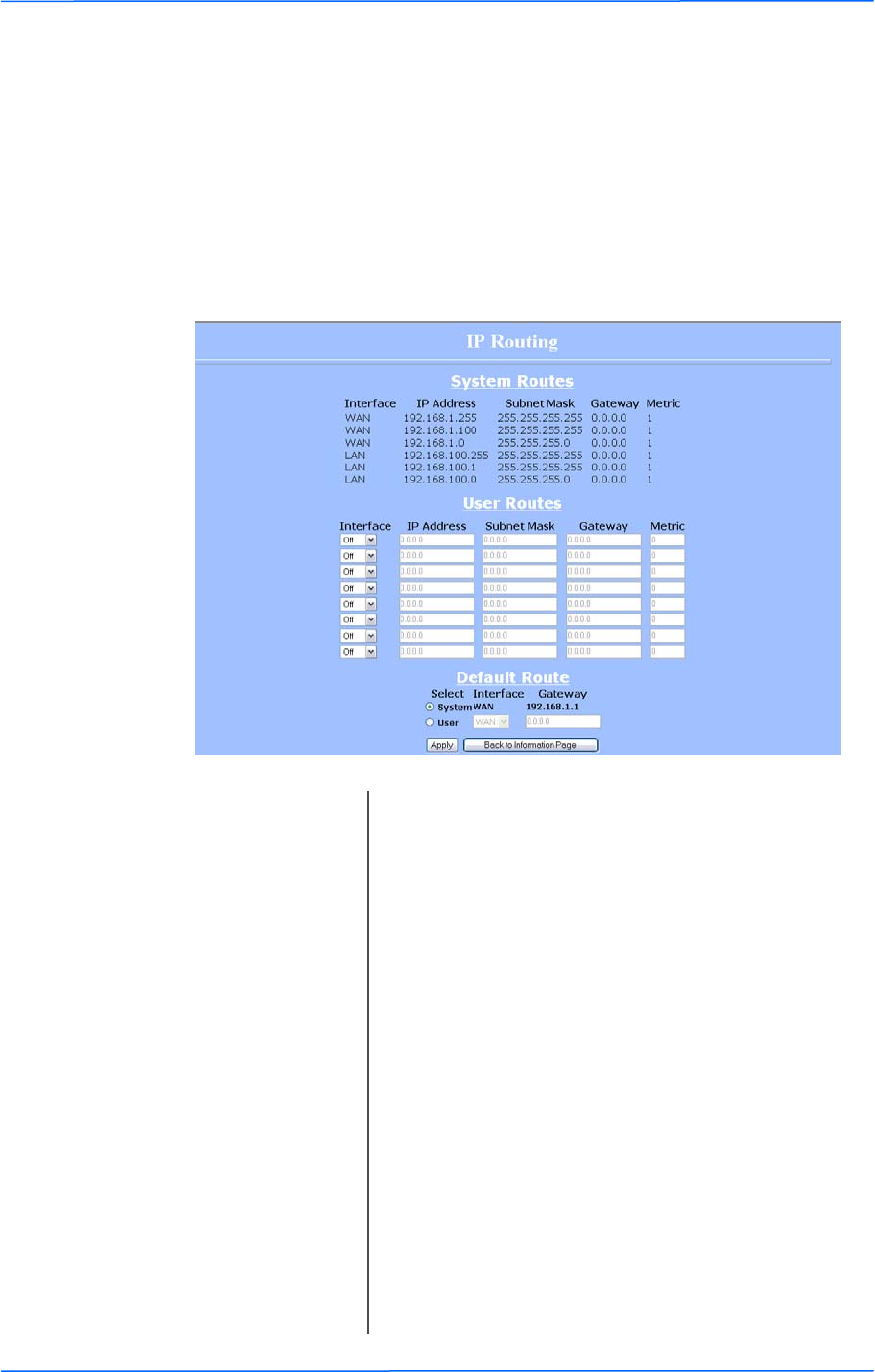
181818
This document is intended for Public Distribution
19473 Fraser Way,
Pitt Meadows, B.C. Canada V3Y 2V4
Chapter 3: Configuration
3-18
TR-Multi Series
Tranzeo Wireless Technologies
IP Routing
This window is intended for those users who have a strong understanding of IP
routing. Here you can see the System Routes, create your User Routes, and set the
Default Route.
IMPORTANT! Be careful when making changes since misconfiguration could
result in serious network problems and even the loss of functionality.
Interface: Specify if the interface is WAN or LAN. Select Off to
disable the route.
IP Address: This is the IP address or network that the packets will
be attempting to access.
Subnet Mask: Specifies the part of the destination IP that represents
the network address and the part that represents the
host address. Note: 255.255.255.255 represents only
the host entered in the Destination IP field.
Gateway: Indicates the next hop if this route is used. A gateway
of 0.0.0.0 means there is no next hop and the IP
address matched is directly connected to the router on
the interface specified.
Metric: This is the number of hops it will take to reach the
destination. A hop occurs each time data passes
through a router from one network to another. If there
is only one router between your network and the
destination network, then the metric value would be 1.
Default Route: This option allows you to change the default route of
the radio. Make changes with extreme caution.
!
!

191919
This document is intended for Public Distribution
19473 Fraser Way,
Pitt Meadows, B.C. Canada V3Y 2V4
Chapter 3: Configuration
3-19
TR-Multi Series
Tranzeo Wireless Technologies
Quality of Service Configuration (QoS)
In this window you can use the QoS features and set rules to prioritize the traffic.
Uplink Speed: This is the maximum speed of the uplink (from the
source to the destination). The order and size of traffic
is determined based on this value.
Dynamic
Fragmentation: Check to reduce delay for high-priority traffic and
adaptive fragmentation where the fragmentation is
determined by the uplink speed. This feature greatly
improves the gaming and VOIP experience.
Automatic
Classification: This feature automatically classifies traffic and gives
priority to certain applications. Applications such as
VOIP and gaming are automatically given priority.
Enabled: Check to activate a rule.
Priority: Enter the priority of the rule between 0 and 255.
Name: Enter the name of the rule here.
Protocol: Enter the protocol number here. Common options are:
0 for ANY, 1 for ICMP, 6 for TCP, and 17 for UDP.
See Appendix C for Protocol List.
Source IP Range: Enter the range of IP addresses on the LAN side where
the rule would apply. To cover all LAN IPs, enter
0.0.0.0. For a single IP, enter the IP in both boxes.
Source Port Range: Enter the range of ports on the LAN side where the
rule would apply. To cover all ports, enter 0. For a
single port, enter this port in both boxes.
Destination IP Range: Enter the range of IP addresses on the WAN side
where the rule would apply.
Destination Port
Range: Enter the range of ports on the WAN side where the
rule would apply.

202020
This document is intended for Public Distribution
19473 Fraser Way,
Pitt Meadows, B.C. Canada V3Y 2V4
Chapter 3: Configuration
3-20
TR-Multi Series
Tranzeo Wireless Technologies
Port Forwarding
This feature allows the radio to forward requests for certain ports to devices
behind a router. For example, you have a web server on a private IP that you want
to be accessible to the world. You can forward all requests on port 80 to
192.168.1.2. For this to work, you have to change the management port of the
radio from port 80 on the Network Configuration window.
In this window, you can create, edit, delete, and manage rules for port forwarding.
A list of port forwarding rules appears at the bottom.
Enable Port
Forwarding: Click to apply rules from the Rules list.
Forward Rule ID: Enter the rule ID here to retrieve its information.
Enabled / Disabled: Activate or deactivate the selected rule.
External Port: Enter the port to which requests will be forwarded.
Internal Port: Enter your port here.
Internal Address: Enter your IP address.
Protocol: Select the protocol used for this rule.
New: Click to create a new rule. Fields will be cleared.
Add: After creating a rule, click this button to include the
new rule in the Port Forwarding Rules list.
Update: Click to apply changes after editing or deleting a rule.
Edit / Delete: Click to modify or remove the selected rule.

212121
This document is intended for Public Distribution
19473 Fraser Way,
Pitt Meadows, B.C. Canada V3Y 2V4
Chapter 3: Configuration
3-21
TR-Multi Series
Tranzeo Wireless Technologies
Port Filtering
This feature allows the radio to block requests to and from devices behind the
router. A list of the devices filtered appears at the bottom of the window.
Enable Port Filtering: Click to apply the rules enabled from the Filter list.
WAN / LAN: Select the network.
Filter Rule ID: Enter the filter rule ID here to retrieve its information.
Allow / Deny: The rule can either allow or deny ports.
Destination IP Range: Enter the range of IP addresses on the WAN side
where the rule would apply.
Source Port Range: Enter the range of ports on the LAN side where the
rule would apply.
Destination Port
Range: Enter the range of ports on the WAN side where the
rule would apply.
ICMP Type: This allows you to block certain types of ICMP as a
prevention against port scanning and some viruses.
Protocol: Select the protocol used for this rule.
Update: Click to apply changes after editing or deleting a filter.
Source IP Range: Enter the range of IP addresses on the LAN side where
the rule would apply.
New: Click to create a new filter. Fields will be cleared and
you may enter the information for the new filter.
Add: After creating a filter, click this button to include the
new filter in the Filter list.
Edit / Delete: Click to modify or eliminate the selected filter.

111
This document is intended for Public Distribution
19473 Fraser Way,
Pitt Meadows, B.C. Canada V3Y 2V4
Appendix A
A-1
TR-Multi Series
Tranzeo Wireless Technologies
What is a proper ground?
This antenna must be grounded to a proper earth ground. According to the
National Electrical Code Sections 810-15s and 810-21, the grounding conductor
shall be connected to the nearest accessible locations of the following:
• The building or structure grounding electrode
• The grounded interior metal water piping system
• The power service accessible means external to enclosure
• The metallic power service raceway
• The service equipment enclosure
• The grounding electrode conductor
Why is coiling the LMR or Cat 5 bad?
The myth is that lighting follows the path of least resistance. It actually follows the
path of least impedance. Coiling cables creates an air-wound transformer, which
lowers the impedance. This means you are in fact making your radios a more
appealing target for surges.
What standard does Tranzeo Wireless equipment meet?
This radio exceeds International Standard IEC 61000-4-5 when properly
grounded. For a copy of the full testing report, see Report Number TRL090904 -
Tranzeo Surge Protection board located on the Tranzeo website
(www.tranzeo.com).
Is lightning damage covered by the warranty?
No. Lightning is not covered by the warranty. If you follow the instructions, your
chances of lightning damage are greatly reduced, but nothing can protect a radio
from a direct lightning strike.
Appendix A: Grounding and Lightning
Protection Information
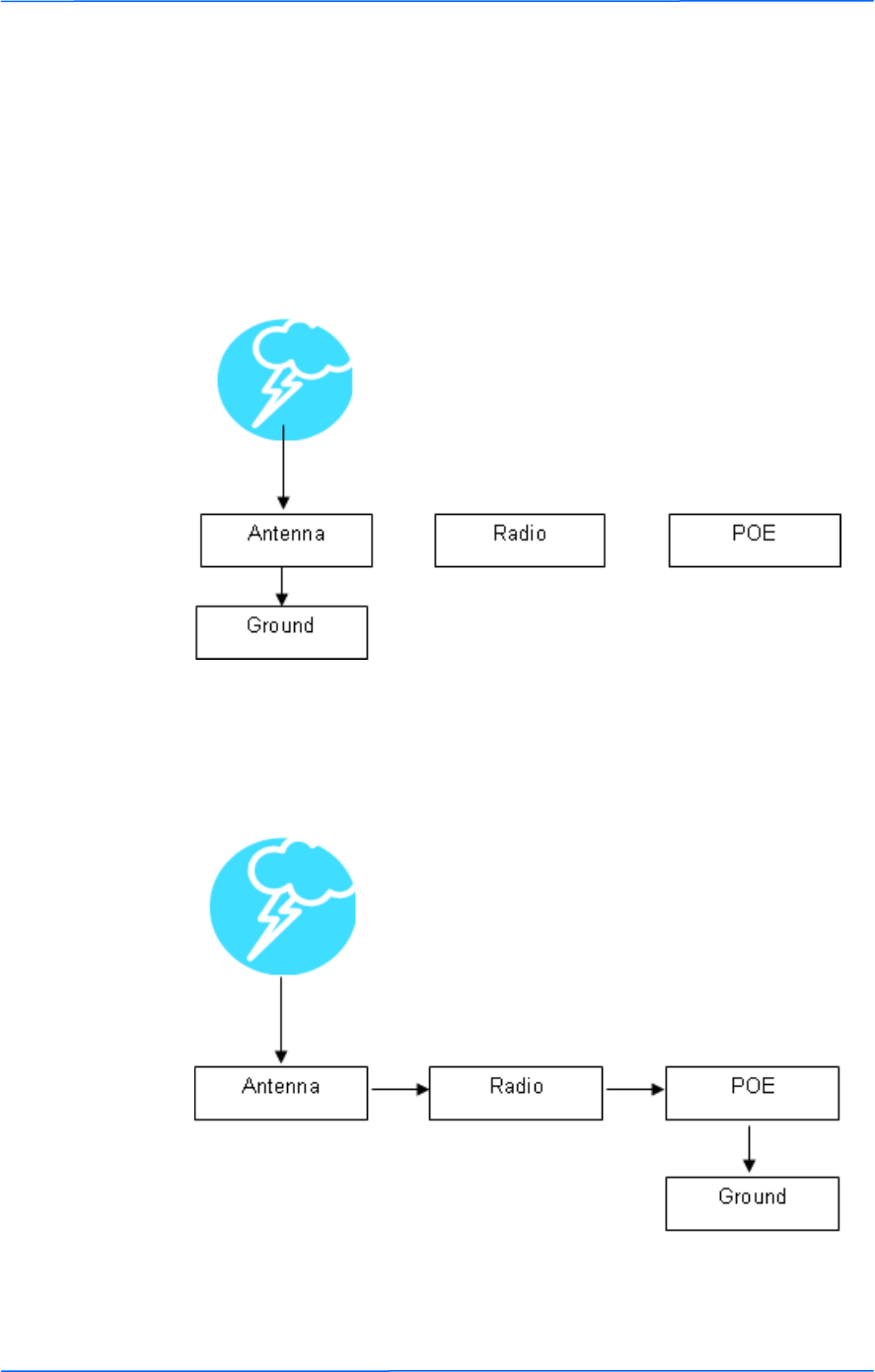
222
This document is intended for Public Distribution
19473 Fraser Way,
Pitt Meadows, B.C. Canada V3Y 2V4
Appendix A
A-2
TR-Multi Series
Tranzeo Wireless Technologies
Where to ground the device?
This radio must be grounded at the pole and at the POE. This is because the radio
is between the exterior antenna and the POE ground. See the examples below.
Grounded Radio
A grounded radio causes the surge to pass directly to ground, bypassing the radio.
Ungrounded Radio
An ungrounded radio causes the surge to pass through the radio. In this case, the
radio most likely will be damaged.
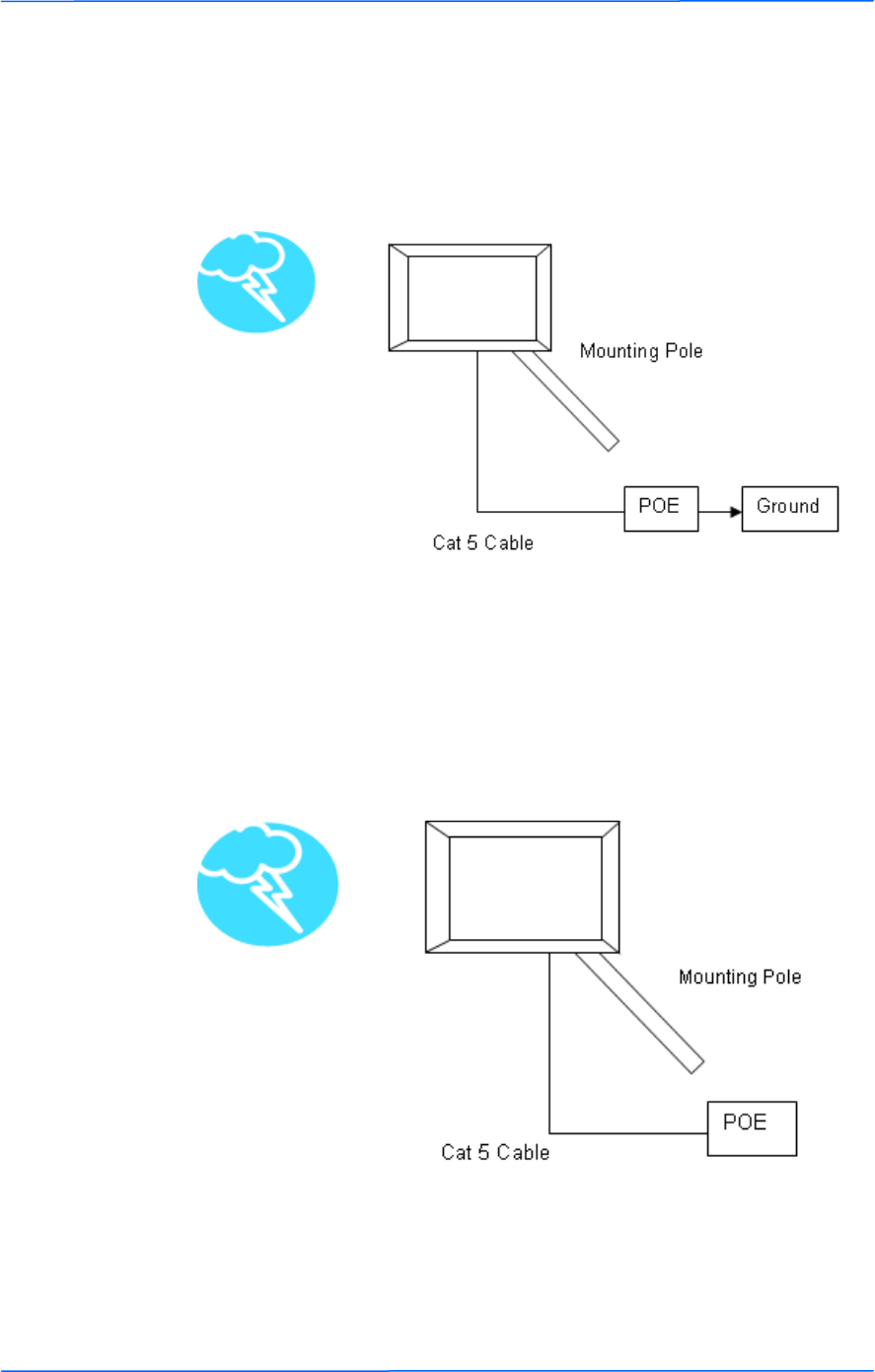
333
This document is intended for Public Distribution
19473 Fraser Way,
Pitt Meadows, B.C. Canada V3Y 2V4
Appendix A
A-3
TR-Multi Series
Tranzeo Wireless Technologies
Grounded POE
In this case, the surge will be picked up by the Cat 5 cable and since the POE is
grounded, the route for the surge is through the POE to ground.
Ungrounded POE
In this case, the surge will be picked up by the Cat 5 cable and since the POE is
not grounded, the route for the surge is through the radio to the antenna, and out
through the building.

111
This document is intended for Public Distribution
19473 Fraser Way,
Pitt Meadows, B.C. Canada V3Y 2V4
Appendix B
B-1
TR-Multi Series
Tranzeo Wireless Technologies
Features
Standard 802.11a/b
Frequency Range 2412 – 2462 MHz; 5280 – 5320 MHz; 5745 – 5825 MHz
Radio Mode Customer Premise Equipment
Data Range & Modulation 11Mbps & 5.5Mbps CCK, 2Mbps DQPSK, 1 Mbps DBPSK
Communication Method Half-Duplex
Transmit Power 23 dBm (2.4 GHz), 17 dBm (5 GHz)
Receiver Sensitivity -90dBm @ 11Mbps (2.4GHz), -76dBm @ 54 Mbps (5 GHz)
Polarization Horizontal or Vertical
Antennas
Model Type
Wind Load (N) Beamwidth
100 mph 125 mph Horizontal Vertical
TR-Multi-N N-Connector 105 165 N/A N/A
TR-Multi-2 16dBi (2.4 GHz),
20dBi (5 GHz) Panel 182 285
18.2° (2.4 GHz )
10.5° (5 GHz) 18.2° (2.4 GHz )
10.5° (5 GHz)
Management
Remote Configuration Based on IP Address
Device Management Windows Utility, Web-Based Management
Protocol Supported TCP/IP
Security 40 bits and 128 bits WEP encryption, Access Control address
filter (MAC), WPA encryption
Ethernet Connector 10/100 BaseT (water tight RJ-45)
Operating Temperature -65°C to +60°C
Warranty 2 year depot
Dimensions
TR-Multi-N 13" X 10-1/8" (radio only)
TR-Multi-2 16" X 14-1/4" (radio only)
Power Supply
Standard AC Wall Plug
Input: 120V 60Hz
Output: 18V, 1000mA
Optional AC Wall Plug
Input: 120V 60Hz
Output: 24V, 1000mA
Specifications are subject to change without notice.
Subject to local regulations.
Appendix B: Product Specification

111
This document is intended for Public Distribution
19473 Fraser Way,
Pitt Meadows, B.C. Canada V3Y 2V4
Appendix C
C-1
TR-Multi Series
Tranzeo Wireless Technologies
Appendix C: Protocol List
Dec Keyword Protocol
0 HOPOPT IPv6 Hop-by-Hop Option
1 ICMP Internet Control Message
2 IGMP Internet Group Management
3 GGP Gateway-to-Gateway
4 IP IP in IP (encapsulation)
5 ST Stream
6 TCP Transmission Control
7 CBT CBT
8 EGP Exterior Gateway Protocol
9 IGP private interior gateway
10 BRM BBN RCC Monitoring
11 NVP-II Network Voice Protocol
12 PUP PUP
13 ARGUS ARGUS
14 EMCON EMCON
15 XNET Cross Net Debugger
16 CHAOS Chaos
17 UDP User Datagram
18 MUX Multiplexing
19 DCN-MEAS DCN Measurement
20 HMP Host Monitoring
21 PRM Packet Radio Measurement
22 XNS-IDP XEROX NS IDP
23 TRUNK-1 Trunk-1
24 TRUNK-2 Trunk-2
25 LEAF-1 Leaf-1
26 LEAF-2 Leaf-2
27 RDP Reliable Data Protocol
28 IRTP Internet Reliable Transaction
29 ISO-TP4 ISO Transport Class 4
30 NETBLT Bulk Data Transfer
31 MFE-NSP MFE Network Services
32 MERIT-INP MERIT Internodal Protocol
33 SEP Sequential Exchange
34 3PC Third Party Connect
35 IDPR Inter-Domain Policy Routing Protocol
36 XTP XTP
37 DDP Datagram Delivery
38 IDPR-
CMTP IDPR Control Message Transport Proto
39 TP++ TP++ Transport Protocol
40 IL IL Transport Protocol
41 IPv6 Ipv6
42 SDRP Source Demand Routing
43 IPv6-Route Routing Header for IPv6
44 IPv6-Frag Fragment Header for IPv6
45 IDRP Inter-Domain Routing
46 RSVP Reservation Protocol
47 GRE General Routing Encapsulation
48 MHRP Mobile Host Routing Protocol
49 BNA BNA
50 ESP Encap Security Payload for IPv6
Dec Keyword Protocol
51 AH Authentication Header for IPv6
52 I-NLSP Integrated Net Layer Security
53 SWIPE IP with Encryption
54 NARP NBMA Address Resolution
55 MOBILE IP Mobility
56 TLSP Transport Layer Security using
Kryptonet key management
57 SKIP SKIP
58 IPv6-ICMP ICMP for IPv6
59 IPv6-NoNxt No Next Header for IPv6
60 IPv6-Opts Destination Options for IPv6
61 any host internal protocol
62 CFTP CFTP
63 any local network
64 SAT-EXPAK SATNET and Backroom EXPAK
65 KRYPTOLAN Kryptolan
66 RVD MIT Remote Virtual Disk
67 IPPC Internet Pluribus Packet Core
68 any distributed file system
69 SAT-MON SATNET Monitoring
70 VISA VISA Protocol
71 IPCV Internet Packet Core Utility
72 CPNX Computer Protocol Network Executive
73 CPHB Computer Protocol Heart Beat
74 WSN Wang Span Network
75 PVP Packet Video Protocol
76 BR-SAT-MON Backroom SATNET Monitoring
77 SUN-ND SUN ND PROTOCOL-Temporary
78 WB-MON WIDEBAND Monitoring
79 WB-EXPAK WIDEBAND EXPAK
80 ISO-IP ISO Internet Protocol
81 VMTP VMTP
82 SECURE-VMTP SECURE-VMTP
83 VINES VINES
84 TTP TTPord Protocol
85 NSFNET-IGP NSFNET-IGP
86 DGP Dissimilar Gateway Protocol
87 TCF TCF
88 EIGRP EIGRP
89 OSPFIGP OSPFIGP
90 Sprite-RPC Sprite RPC Protocol
91 LARP Locus Address Resolution
92 MTP Multicast Transport Protocol
93 AX.25 AX.25 Frames
94 IPIP P-within-IP Encapsulation
95 MICP Mobile Internetworking Control
96 SCC-SP Semaphore Communications Sec.
97 ETHERIP Ethernet-within-IP Encapsulation
98 ENCAP Encapsulation Header
99 any private encryption scheme
100 GMTP GMTP

222
This document is intended for Public Distribution
19473 Fraser Way,
Pitt Meadows, B.C. Canada V3Y 2V4
Appendix C
C-2
TR-Multi Series
Tranzeo Wireless Technologies
Dec Keyword Protocol
101 IFMP Ipsilon Flow Management
102 PNNI PNNI over IP
103 PIM Protocol Independent Multicast
104 ARIS ARIS
105 SCPS SCPS
106 QNX QNX
107 A/N Active Networks
108 IPComp IP Payload Compression
109 SNP Sitara Networks Protocol
110 Compaq-Peer Compaq Peer Protocol
112 VRRP Virtual Router Redundancy
113 PGM PGM Reliable Transport
114 any 0-hop protocol
115 L2TP Layer Two Tunneling Protocol
116 DDX D-II Data Exchange (DDX)
111 IPX-in-IP IPX in IP
117 IATP Interactive Agent Transfer
118 STP Schedule Transfer Protocol
119 SRP SpectraLink Radio Protocol
120 UTI UTI
Dec Keyword Protocol
121 SMP Simple Message Protocol
122 SM SM
123 PTP Performance Transparency
124 ISSIS ISIS over IPv4
125 FIRE
126 CRTP Combat Radio Transport
127 CRUDP Combat Radio User Datagram
128 SSCOPMCE
129 IPLT
130 SPS Secure Packet Shield
131 PIPE Private IP Encapsulation within IP
132 SCTP Stream Control Transmission
133 FC Fibre Channel
134
135 Mobility header
136 UDPLite
137 MPLS-in-IP
138-252 Unassigned
253 Use for experimentation and testing
254 Use for experimentation and testing
255 Reserved
RSVP-E2E-IGNORE

111
This document is intended for Public Distribution
19473 Fraser Way,
Pitt Meadows, B.C. Canada V3Y 2V4
Appendix D
D-1
TR-Multi Series
Tranzeo Wireless Technologies
Appendix D: Common TCP Ports
Visit http://www.iana.org/assignments/port-numbers for a full list of well known
port numbers.
Keyword Port Description
ECHO 7 Echo
SYSTAT 11 Active Users
QOTD 17 Quote of the day
MSP 18 Message Send Protocol
FTP-DATA 20 File Transfer (Data Channel)
FTP 21 File Transfer (Control)
TELNET 23 Telnet
SMTP 25 Simple Mail Transfer
NAME 42 TCP Nameserver
BOOTPS 67 Bootstrap Protocol Server
BOOTPC 68 Bootstrap Protocol Client
TFTP 69 Trivial File Transfer
WWW 80 World Wide Web
KERBEROS 88 Kerberos
POP3 110 TCP post office
NNTP 119 USENET
NFS 2049 Network File System
SIP 5060, 5061 SIP

111
This document is intended for Public Distribution
19473 Fraser Way,
Pitt Meadows, B.C. Canada V3Y 2V4
Appendix E
E-1
TR-Multi Series
Tranzeo Wireless Technologies
Appendix E: Channel Allocations
The following tables list the channel numbers and center frequencies used for
802.11a and 802.11b/g. Note that while all of these frequencies are in the
unlicensed ISM and U-NII bands, not all channels are available in all countries.
Many regions impose restrictions on output power as well as indoor and outdoor
use on some channels. These regulations are rapidly changing, so always check
your local regulations before transmitting.
These tables show the center frequency for each channel. Channels are 22 MHz
wide in 802.11b/g and 20 MHz wide in 802.11a.
802.11b/g
Channel
# Center Frequency
(GHz) Channel
# Center Frequency
(GHz)
1 2.412 8 2.447
2 2.417 9 2.452
3 2.422 10 2.457
4 2.427 11 2.462
5 2.432 12 2.467
6 2.437 13 2.472
7 2.442 14 2.484
802.11a
Channel
# Center Frequency
(GHz) Channel
# Center Frequency
(GHz)
34 5.170 52 5.260
36 5.180 56 5.280
38 5.190 60 5.300
40 5.200 64 5.320
42 5.210 149 5.745
44 5.220 153 5.765
46 5.230 157 5.785
48 5.240 161 5.805

111
This document is intended for Public Distribution
19473 Fraser Way,
Pitt Meadows, B.C. Canada V3Y 2V4
Appendix F
F-1
TR-Multi Series
Tranzeo Wireless Technologies
Tranzeo Wireless Technologies’ software ensures a consistently high quality
online experience through the use of powerful Quality of Service (QoS)
mechanisms. The key to making this applicable in a WISP environment is the
Intelligent Stream Handling, a patent-pending algorithm that autonomously
manages the flow of traffic going to the Internet without the need for user
configuration. As a result, real-time, interactive traffic—such as gaming, VoIP,
and video teleconferencing—is automatically given the appropriate priority when
other users and applications use the connection. In addition, Intelligent Stream
Handling minimizes the impact of large packet, lower priority traffic on latency-
sensitive traffic and eliminates delays. Tranzeo software effectively eliminates the
lag and breakup problem in online gaming and other voice and video applications.
In today's broadband environment, the impact of just one data stream running in
parallel with a real-time application can be quite dramatic. Using NetIQ's Chariot
VoIP test measurement over a connection, it can be demonstrated that introducing
a single FTP transfer in the upstream direction will reduce the Mean Opinion
Score (MOS) for a G.729 VoIP codec from a very good 4.4 to a completely
unacceptable level of 1 immediately. Using the same scenario with Tranzeo’s QoS
enabled, the voice quality remains consistently high with an MOS of 4.4, and
maintains that level even with multiple FTP streams.
Automatic Traffic Classification
Tranzeo software has the capability of continually monitoring and classifying
traffic on the Internet connection, and dynamically adjusting the way individual
streams are handled at any point in time. This enables latency-sensitive traffic—
such as voice, games, or even web page requests— to be given a relatively high
priority. As a result, these packets are sent to their destination first, reducing delay
and jitter. Less time-sensitive traffic—such as email or file transfers—are sent at
lower priority. Since Intelligent Stream Handling operates automatically without
the need for user configuration, it is able to effectively use 255 priority levels for
fine-grained control of the packet streams.
Rate Matching
A process called "rate matching" determines the bandwidth of the broadband
uplink automatically so that it can shape the traffic to smooth the flow between the
router and the Internet. This eliminates the potential bottlenecks and delays that
can be caused by "bursty" data traffic.
Dynamic and Adaptive Link Fragmentation
Low priority traffic is also fragmented to reduce the latency and jitter that can be
introduced by long packets. Intelligent Stream Handling adjusts the fragment size
based on the uplink speed and also stops fragmenting long packets when no
latency-sensitive traffic is waiting to be sent, to improve the overall efficiency of
the broadband link and ensure voice can sustain a high MOS rating.
Appendix F: Quality of Service
Configuration (QoS)
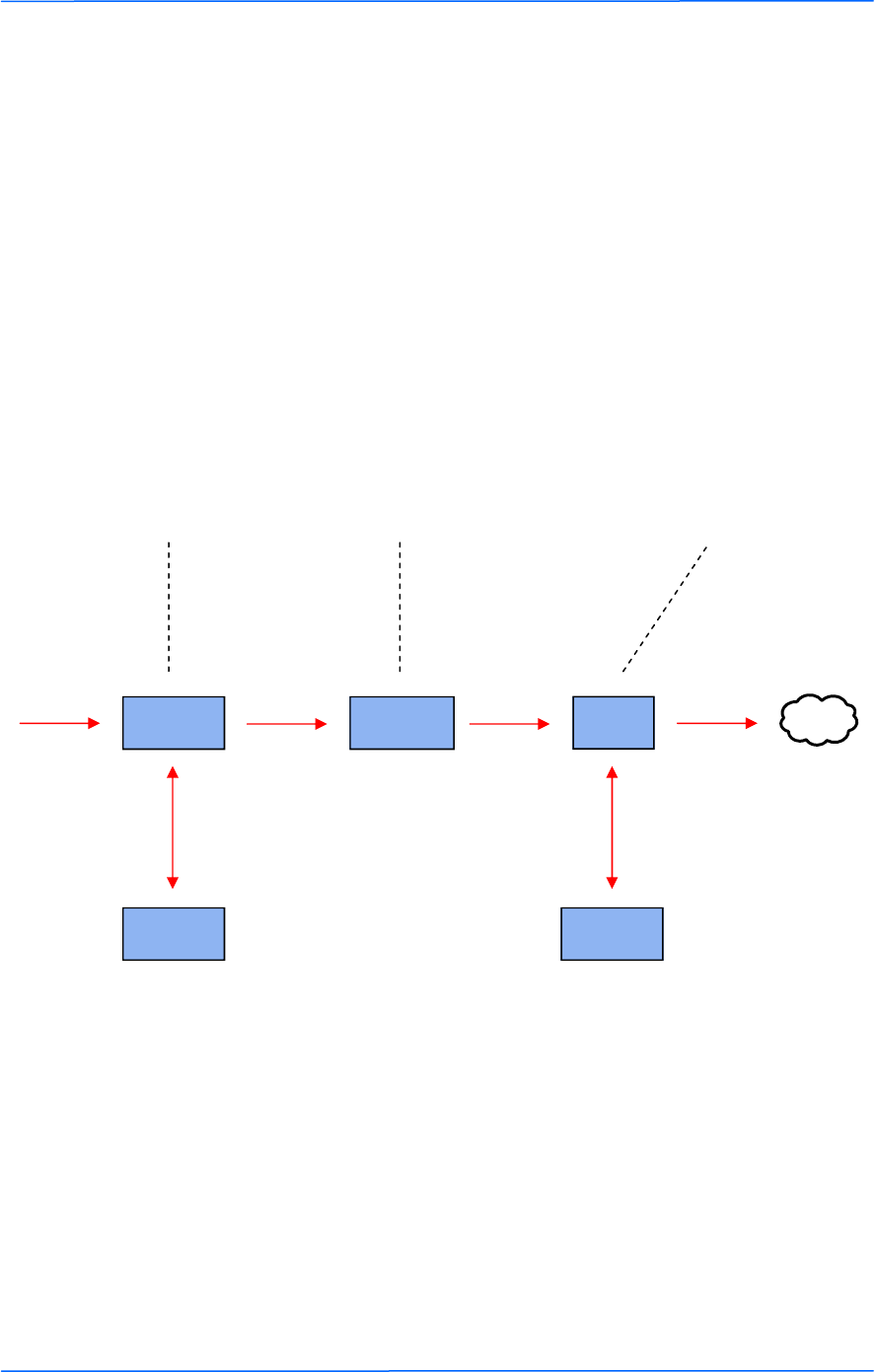
222
This document is intended for Public Distribution
19473 Fraser Way,
Pitt Meadows, B.C. Canada V3Y 2V4
Appendix F
F-2
TR-Multi Series
Tranzeo Wireless Technologies
QoS Block Diagram
Tranzeo software has the capability of
continually monitoring and classifying
traffic on the Internet connection, and
dynamically adjusting the way
individual streams are handled at any
point in time. This enables latency-
sensitive traffic, such as voice, games
or even web page requests, to be given
a relatively high priority. As a result,
they are sent to their destination first,
reducing delay and jitter. Less time-
sensitive traffic such as email or file
transfers are de-prioritized.
Dynamic
Fragmentation
Automatic
Classification Rate
Matching
High Priority High Priority High Priority High Priority Internet
Non-latency-
sensitive traffic
Low-priority or
excess traffic
Queue Queue
Intelligent Stream Handling
adjusts the fragment size based
on the uplink speed and also
stops fragmenting long packets
when no latency-sensitive traffic
is waiting to be sent, to improve
the overall efficiency of the
broadband link and ensure voice
can sustain a high MOS (Mean
Opinion Score) rating.
A process called "rate matching"
determines the bandwidth of the
broadband uplink automatically so
that it can shape the traffic to
smooth the flow between the router
and the Internet. This eliminates
the potential bottlenecks and delays
that can be caused by "bursty" data
traffic.

333
This document is intended for Public Distribution
19473 Fraser Way,
Pitt Meadows, B.C. Canada V3Y 2V4
Appendix F
F-3
TR-Multi Series
Tranzeo Wireless Technologies
Network QoS Example
Internet
Bandwidth
Shaper
5A PxP
30 MB
5A PxP
6000 AP
QoS
6000 CPE
Shaped to 2 MB
QoS
6000 CPE
VOIP
Computer
Computer
Shaped to 1 MB
In this case, no user is ever
able to draw more than their
fair share of the available up
stream bandwidth, even if the
communication is between
two stations on the same
access points.
In this case, the head end
shaper is limiting the
incoming demand based on
the end user to ensure no
user is taking the entire
downstream.
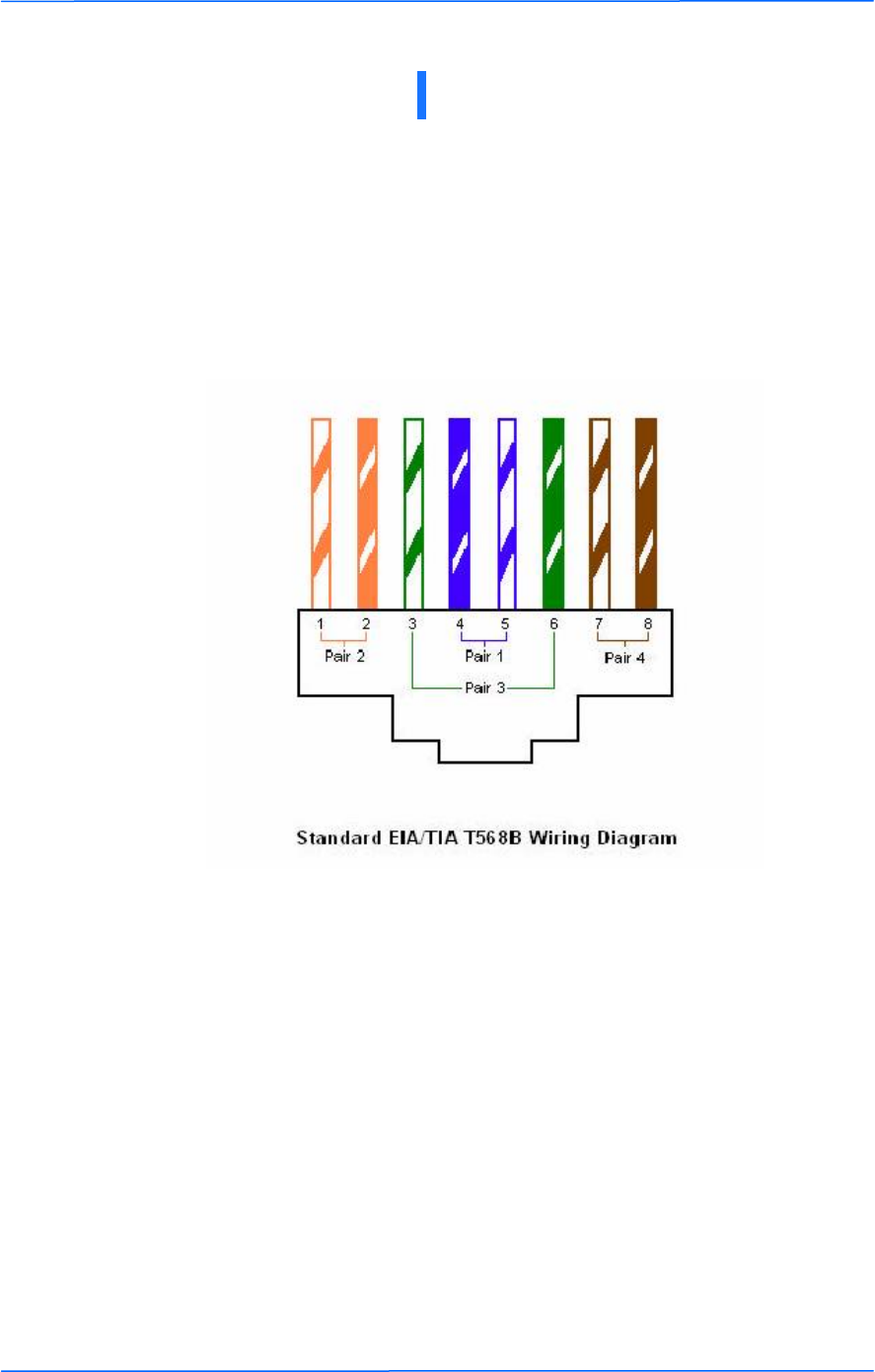
111
This document is intended for Public Distribution
19473 Fraser Way,
Pitt Meadows, B.C. Canada V3Y 2V4
Appendix G
G-1
TR-Multi Series
Tranzeo Wireless Technologies
TIA/EIA-568-B is a set of standards for cabling telecommunications products and
services. Follow these standards, as described in the diagram below, to wire the
Cat 5 cable during installation of the Tranzeo radio (see Step 3 in Chapter 2:
Hardware Installation - Installing the Ethernet Cable).
Appendix G: Wiring Standard